NEET Biology Notes Human Health And Disease
Health
- The term “health” is very frequently used by everybody. How do we define it?
- Health does not simply mean absence of disease or physical fitness.
- It can be defined as a state of complete physical, mental, and social well-being.
- When people are healthy, they are more efficient at work.
- This increases productivity and brings economic pros- perity.
- Health also increases longevity of people and reduces infant and maternal mortality.
- Balanced diet, personal hygiene, and regular exercise are very important to maintain good health.
- Yoga has been practiced since time immemorial to achieve physical and mental health.
- Awareness about diseases and their effect on different bodily functions, vaccination (immunization) against infectious diseases, proper disposal of wastes, control of vectors, and maintenance of hygienic food and water resources are necessary for achieving good health.
Disease
- When the functioning of one or more organs or systems of the body is adversely affected, characterized by various signs and symptoms, we say that we are not healthy, i.e., we have a disease.
- Diseases can be broadly grouped into infectious and non-infectious.
- Diseases that are easily transmitted from one person to another are called infectious diseases.
- Infectious diseases are very common and each one of us suffers from these at some time or the other.
- Some infectious diseases such as AIDS (acquired immuno deficiency syndrome) are fatal.
- Among non-infectious diseases, cancer is the major cause of death.
- Drug and alcohol abuse also affect our health adversely.
- Disease can be defined as a disorder of the mind or body.
- This term covers varied conditions leading to the deviation of human body from the normal course or deviation from the normal health.
- Thus, disease is opposed to health.
- Since time immemorial, diseases have been a prime concern of man.
- Early man thought that diseases were caused by evil spirits. Hence, cure consisted of pacifying the evil spirits with the help of charms and magic.
- Hippocrates (460-359 BC), the great Greek physician, was the first to separate medicine from religion and superstition.
- He gave the description of disease symptoms and emphasized the need for good diet, fresh air, and rest.
- He also described that human body has a natural tendency to defend itself against diseases.
- Pathogen: It is an organism which is capable of producing a disease.
- The ability of the pathogen to gain entrance and produce symptoms of disease is called pathogenicity.
- Virulence is the degree of pathogenicity of a pathogen in the host body.
- Pathogens are biological agents including bacteria, fungi, viruses, mycoplasma, protozoans, helminths, etc.
- A parasite is an organism that lives at the expense of the other organism, called host, for obtaining food and shelter.
- A parasite may cause disease in the host.
- Infection is the interaction between the host and the parasite having a competition for superiority.
- Disease occurs when the parasitic organism is able to win.
- Infection or transmission may occur by contact; through air, food, water, and insect bite; or by contaminated materials.
- Researches in parasitology described the causative organisms (parasites) of diseases.
- Our knowledge of human parasites developed after the invention of microscope in 1835.
Read and Learn More NEET Biology Notes
Categories of Diseases
- Diseases can be broadly divided into two groups: congenital and acquired.
- Congenital diseases: These occur since birth and. may result from metabolic disorder or defect in development.
- Acquired diseases: These develop after birth and can be further divided into two main categories:
- Communicable diseases: These rapidly spread from one person to another, e.g., infectious diseases.
- Non-communicable diseases: These do not spread from person to person. These include all other acquired diseases.
NEET Biology Notes Human Health And Disease Communicable Diseases
- The infectious diseases rapidly spreading from person to person are called communicable diseases.
- Communicable diseases can be categorized on the basis of different aspects.
- On the basis of transmission, these may be divided into the following categories:
- Transmitted through air
- Transmitted through food and water
- Transmitted through insect bite
- Transmitted by contact
- On the basis of causative organism or pathogen, these diseases may be categorized into the following categories:
- Bacterial
- Viral
- Protozoic
- Helminthic
- Fungal diseases
” human health and disease”
NEET Biology Notes Human Health And Disease Diseases Caused By Viruses
- Common cold
- Common cold is one of the most infectious human ailments.
- It is caused by rhinoviruses.
- They infect the nose and respiratory passage but not the lungs.
- Common cold is characterized by nasal congestion and discharge, sore throat, cough, headache, tiredness, hoarseness, etc., for 3 to 7 days.
- Influenza
- It is commonly known as “flu” and is highly infectious.
- It causes fever and pain all over the body and affects the nose, throat, and air passages as in common cold.
- The disease is caused by various types of influenza viruses (e.g., Myxovirus influenzae).
- It is characterized by with fever, headache, sore throat, cold with sneezing, and pain all over the body with restlessness.
- In neglected cases, complications such as pneumonia, bronchitis, and ear infections may develop.
- There is no vaccine at present which can give protection against all types of influenza viruses as each epidemic is of a different type.
- Smallpox (variola)
- It is a highly infectious disease starting with high fever, chill, backache, and headache, followed by the appearance of rash on the third day of illness.
- The rash appears first on the face and then on the rest of the body (periphery to center).
- It is more on the face and limbs and less on the trunk.
- It starts as small reddish spots which change into papules.
- These in turn change into small vesicles containing clear fluid.
- Vesicles change into pustules.
- Finally, a scab is formed and it falls off by the third week.
- These scabs leave deep pits or scars known as pock marks.
- Many children become blind and develop discharge from the ear.
- This disease is caused by a smallpox virus named variola virus (dsDNA virus).
- The virus is present in the oral and nasal dis- charge of the patient and is ejected during the acts of coughing, sneezing, fomites, etc. It infects healthy people.
- Vaccination against smallpox is one of the best preventive remedies available today.
- This was discovered by Edward Jenner in 1798.
- Smallpox has been eradicated from India.
- Chicken pox (varicella)
- It is a mild but highly infectious disease causing slight fever and a rash which undergoes changes in vesicles, pustules, and, finally, a dark brown scab which falls off leaving no scar unlike small-pox.
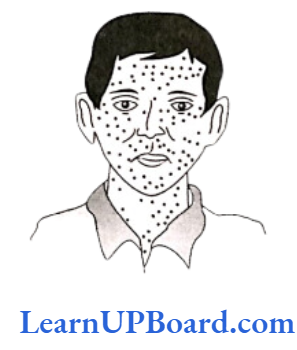
- The rash comes out in crops. With each fresh crop, there may be slight fever again.
- The rash first appears on the trunk. There are more lesions on the trunk than on the face and limbs.
- The disease is caused by a virus of chicken pox named varicella-zoster which is passed out in the discharges of the respiratory tract of an infected person directly as droplets or through contaminated articles used by him.
- Vaccination against chicken pox is now available.
- The most common late complication of chicken pox is shingles caused by the reactivation of varicella-zoster.
- Measles (rubeola disease)
- Measles is a highly infectious disease causing fever, inflammation of the air passages, and a rash all over the body.
- It especially attacks children below the age of 5 years; those who have escaped may be attacked even in the later life.
- It is caused by rubeola virus (RNA virus) which is passed out in the secretions of nose and throat of the infected person as droplets or in articles soiled by these secretions.
- The disease starts with the catarrh of nose and throat, and fever.
- The eyes become red and watery, and the face becomes flushed.
- Rash which is slightly pinkish in color appears first on the back of the ear and face, and then spreads downwards on the body.
- Mumps (infectious parotitis)
- It is an infectious disease causing fever, difficulty in opening the mouth, and painful swelling of the parotid glands which lie just below the lobe of the ears.
- It is caused by paramyxovirus (RNA virus), which comes out in the saliva of the infected person.
- The patient should take complete bed rest till the swelling subsides in order to avoid complications.

- Usually, there are no complications. But in some cases, there may be pain and swelling of the testes (orchitis) or pain in the abdomen.
- Poliomyelitis
- This disease was called infantile paralysis.
- But it is now known that the disease may occur at any age.
- This disease spreads mainly through intestinal discharges.
- It may also spread through contaminated food or drink and by flies or other insects that may contaminate food or drink.
- Polio virus (ssRNA) usually enters the body via alimentary canal where it multiplies and reaches the nervous system (spinal cord) through the bloodstream.
- Its incubation period is 7-14 days.
- It produces inflammation of the nervous system.
- The earliest sign of this disease is the involvement of central nervous system causing inability to bend the head forward.
- Stiffness of the neck is an important sign. Paralysis starts following the weakness of particular skeletal muscles.
- The attack of paralysis begins with high fever, headache, chills, and pain all over the body.
- If the muscles of larynx and pharynx are involved, it proves fatal.
- Within 2-3 days, the paralysis reaches its maximum.
- There is no sure cure for polio.
- The patient should be kept isolated.
- He should be given complete rest.
- An adequate arrangement for the proper disposal of urine and feces of the patient must be provided because these contain polio virus.
- Overcrowding of children in schools, playgrounds, and cinemas should be avoided.
- Polio is preventable. Polio vaccine is safe and effective.
- Now-a-days, multiple vaccines are used against polio, diphtheria, whooping cough, and tetanus simultaneously.
- Trachoma
- It is caused by Chlamydia trachomatis.
- Trachoma is a chronic inflammatory disease of the eye affecting the conjunctiva and cornea.
- It is characterized by the development of granules. Its common symptoms are inflammation, pain, and watering of the eye.
- It can lead to blindness.
- Infection spreads by direct contact and by the use of handkerchiefs, towels, and pillows of the patient.
- Rabies (hydrophobia):
- It is caused by Rhabdovirus.
- It is introduced in the body by the bite of rabid (mad) dogs usually.
- It can be injected by the bite of jackels, wolves, cats, etc. Incubation period is from 10 days to 1 year.
- Fear of water is the most important characteristic symptom of this disease.
- Other symptoms are saliva from the mouth, severe headache, high fever, alternating periods of excitement and depression, and inability to swallow even fluids due to choked throat.
- The virus destroys the brain and spinal cord. Rabies is 100% fatal.
- There should be compulsory immunization of dogs and cat population.
- Dengue fever
- Dengue fever is caused by an RNA containing arbovirus (arthropod borne virus) of Flavivirus group which also causes yellow fever (not found in India).
- Thus, the virus that causes dengue fever is a mosquito borne flaviribo virus.
- The virus of dengue fever is transmitted by the bite of female Aedes aegypti (mosquito).
- Incubation period is 3-8 days.
- These fevers are of two types: classical dengue fever and dengue hemorrhagic fever.
- The symptoms of classical dengue fever are as follows:
- Abrupt onset of high fever.
- Severe frontal headache.
- Pain behind the eyes which worsens with eye movement.
- Muscles and joint pain.
- Loss of sense of taste and appetite.
- Measles-like rash over chest and upper limbs.
- Nausea and vomiting.
- The symptoms of dengue hemorrhagic fever are similar to those of classical dengue fever except the following:
- Bleeding from nose, mouth, and gums, and skin bruising.
- Severe and continuous stomach pains.
- Frequent vomiting with or without blood.
- Pale cold or clammy skin.
- Excessive thirst (dry mouth).
- Rapid weak pulse.
- Difficulty in breathing.
- Restlessness and constant crying.
- If there is fever, consult the doctor at once; take Paracetamol tablets on the advice of doctor.
- Do not take Aspirin and Disprin.
- Do cold sponging if fever is high.
- Give plenty of liquids to the patient.
- Rush the patient to the hospital if there is bleeding from any part of the body or if the patient be- comes unconscious.
- No vaccine for dengue fever is available.
- Eliminate mosquito breeding places by covering small water containers and water tanks, and changing the water of cooler every week-where Aedes mosquitoes breed.
- Wear clothes that cover arms and legs.
- Do not allow children to play in shorts and half-sleeved clothes.
- Use mosquito repellents and repellent cream, and sleep in mosquito-net.
- Chikungunya
- It is caused by Chikungunya virus.
- This virus was first isolated from human patients and Aedes aegypti mosquitoes from Tanzania in 1952.
- The name “Chikungunya” is derived from the native word for the disease in which patient walks “doubled up” due to severe joint pain.
- Its symptons include sudden onset of fever, crippling joint pain, lymphadenopathy, and conjuctivitis.
- Some show hemorrhagic manifestations.
- No vaccine is available.
” health and disease”
NEET Biology Notes Human Health And Disease Diseases Caused By Bacteria
- Cholera
- This is an acute infectious disease caused by Vibrio cholerae.
- These may get into a healthy person with contaminated food and water.
- The patient starts passing stools frequently, which are white like rice water, and gets repeated vomiting.
- Since a large quantity of fluid and salts are rapidly lost through stools and vomit, the most important dose treatment is to replace the lost fluid and salts equally rapidly.
- Rapid replacement of fluid and elecrolytes is done by oral rehydration therapy.
- Typhoid
- It is an infectious disease caused by Gram-negative bacterium called Salmonella typhi which is a non-spore forming bacillus.
- Typhoid germs are contracted from food or drink contaminated with excreta from carriers or patients.
- The spread is facilitated by poor environmental hygiene. Immunity following the infection is not sufficient to prevent relapse.
- A large number of organisms have to be ingested by a healthy person to suffer from typhoid.
- Smaller number may produce the disease if the organism is very virulent or if the resistance of the host is poor.
- The acid in stomach destroys Salmonella that is ingested. Hence, patients having achlorhydria (no acid in stomach) or who take large amounts of antacids to neutralize the acid in stomach suffer more often from typhoid.
- The normal intestinal flora produces short-chain fatty acids which are lethal to Salmonella.
- When this is reduced by antibiotics, the patient is more prone to typhoid.
- Salmonella that causes enterocolitis after ingestion invades the mucosal cells and multiplies within them.
- These bacteria do not penetrate beyond lamina propria and multiply in the lymphoid tissues (Peyer’s patches) of the small intestine.
- Inflammatory changes occur with the accumulation of leucocytes.
- Enterotoxin liberated by the bacteria may form abscess which may burst causing ovoid ulcers. This may cause hemorrhage. If the ulcer reaches the serosa, perforation occurs leading to peritoni- tis.
- The infection is usually localized in the small in- testine and colon.
- The incubation period is usually 12-72 h but may be up to 2 weeks.
- Nausea, vomiting, and an early chill are common initially followed by colicky abdominal pain and diarrhoea of watery, green, offensive stools.
- Blood mixed with stool and high fever may occur if there is involvement of colon.
- Symptoms may subside within a week or two.
- There is clinical syndrome characterized by fever, headache, cough, splenomegaly, and leucopenia.
- This is called enteric fever.
- The fever is continuous and rises in a step-wise manner.
- Diagnosis is done by the Widal test which determines the agglutinins against the antigen.
- The test is usually positive in the second week of the disease.
- The concentration of agglutinins must keep on rising with time to suggest the disease.
- The treatment involves the use of antibiotics, antipyretics, and rest. TAB vaccine is useful against typhoid.
- Special care must be taken to ensure that persons who are engaged as cooks or work in eating establishments are not “carriers” of this disease (who can keep spreading this disease through food).
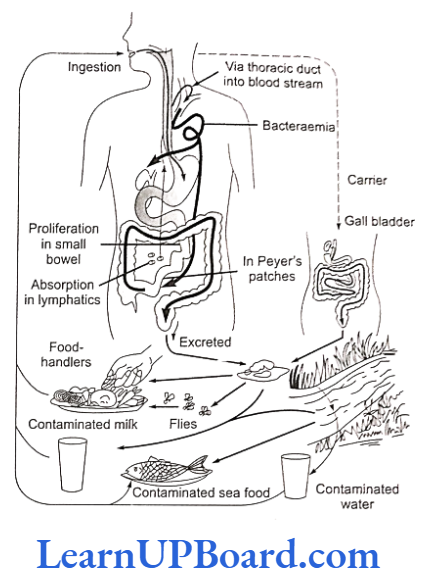
- Diphtheria
- This disease is caused by Corynebacterium diphtheriae usually affecting children up to 5 years of age.
- It may start as sore throat, chills with mild fever, and, sometimes, vomiting and headache.
- Throat and/or tonsils show a gray membrane which may spread down and cause hoarseness and difficulty in breathing.
- Nose may be affected giving rise to a blood-tinged nasal discharge from one nostril.
- If the disease is not treated early and properly, the toxin produced by the germs affects the heart and the nervous system, and proves fatal.
- The most important preventive measure against this disease is that all babies should be immunized within the first six weeks of birth using DPT vaccine.
- Whooping cough (pertussis)
- It is a highly infectious disease of young children causing inflammation of the respiratory passage with severe attacks of cough.
- It is caused by Bordetella pertussis, which comes out while coughing from the discharges of the nose and throat of the patient.
- It spreads by the direct inhalation of droplets from the patient or the carrier or by the articles freshly soiled by the discharges.
- The cough becomes troublesome, especially at night.
- The face becomes red during coughing.
- These repeated bouts of violent cough end in a whoop.
- Whooping sound is produced due to rushing in of air during deep inspiration at the end of a bout of cough.
- The child usually vomits and there is frothy discharge from his mouth and nose.
- The disease can be prevented by immunizing all infants with whooping cough vaccine which is available singly or in combination as triple vaccine (i.e., DPT).
- Pneumonia
- This disease is caused by Diplococcus pneumoniae.
- Pneumonia is a serious disease of lungs.
- Lymph and mucus collect in the alveoli and bronchioles of lungs so that lungs do not get sufficient air.
- Therefore, proper exchange of gases does not take place in the alveoli.
- It usually lowers the resistance of the body.
- Infection spreads by the sputum of the patient.
- Breathing rate increases with high-grade fever. It is common in children below the age of 5 years.
- Tetanus (lockjaw)
- It is caused by Clostridium tetani.
- The first indications of this disease are irritability and restlessness; the neck becomes stiff and there is difficulty in chewing and swallowing.
- Subsequently, spasms of muscles of the jaw and face take place and, thus, “lockjaw” occurs.
- There is severe pain.
- It is often a fatal disease.
- The toxin mainly affects “voluntary muscles.”
- Tetanus organisms live in the intestines of horses and other animals without doing any harm. The spores are, therefore, abundant in the soil manufactured with animal dung.
- Spores may survive for 60 years or more in contaminated soil.
- On entering the body by way of wounds, the spores release active bacteria.
- The latter multiply and secrete powerful exotoxin into the tissue and blood.
- The exotoxin known as tetanospasmin brings about tetanus.
- Anti-tetanus serum (ATS) injection should be ad- ministered in case of an injury.
- Plague
- This disease is characterized by high fever and a bubo (painful swelling) in the groin or the armpit.
- Plague is caused by Yersinia pestis-a deadly bacterium.
- It is primarily a disease of rodents but it accidently affects man.
- It gets transmitted from rat to rat through the rat fleas.
- But when a rat dies of plague, the fleas leave the dead rat; if any man is around, they bite him and accidently inject some plague germs into his blood.
- In its typical form, bubonic plague is not transmitted from one man to another, but always from a rat to one or more men.
- Tuberculosis (TB)
- It is also called Koch’s disease.
- It is caused by Mycobacterium tuberculosis.
- The bacteria damage the tissues and release a toxin named tuberculin which produces the disease.
- It affects the lungs, lymph nodes, bones, and joints.
- Incubation period is quite variable.
- The symptoms of pulmonary (lungs) tuberculosis are fever, cough, blood-containing sputum, pain in the chest, loss of weight, excessive fatigue, failure of appetite, rise of temperature in the evening, hoarseness of throat, night sweating, and rapid pulse.
- BCG vaccine gives considerable protection against tuberculosis.
- Leprosy (Hansen’s disease)
- This disease is caused by Mycobacterium leprae, which was discovered by Hansen.
- The symptoms of leprosy include the appearance of light-colored patches on the skin, thickening of nerves, and partial or total loss of sensation in the affected parts of the body.
- These are accompanied by fever, pain, ulcers, and skin eruptions.
- Deformities of toes and fingers may also develop.
- The bacilli leave the body in nasal discharge from the throat during coughing, sneezing, and even speaking, and through broken skin lesions. The patient is treated with DDS (diamino diphenyl sulfone).
NEET Biology Notes Human Health And Disease Disease Spread By Protozoa
- Malaria
- Of all the communicable diseases caused by protozoa, malaria is the most destructive for man. Malaria is widespread in the tropics and subtropics and also in certain areas of temperate zones.
- It was earlier thought to be caused by foul gases emanating from marshes. Hence, the disease was named malaria (Italian, mala-bad, aria-air).
- The term malaria was given by Maculoch (1837).
- A French army doctor, Charles Laveran (1880), discovered malaria parasite (Plasmodium vivax and P. malariae) in the RBC of malaria patient.
- Stephens discovered P. ovale and Welch discovered P. falciparum. Lancisi suspected that malaria occurs where mosquitoes are found.
- Richard Pfeiffer (1892) explained that some blood-sucking insects are involved in the transmission of malaria.
- Scottish doctor, Patrick Manson (1894) suggested that mosquito has some role in the transmission of malaria.
- A doctor in Indian Army, Sir Ronald Ross (1897) established relationship between mosquito and malaria.
- On August 29, 1897, Ronald Ross discovered the oocysts of Plasmodium on the stomach of female Anopheles mosquito.
- Hence, August 29 is observed as the Mosquito Day.
- For his valuable discovery, Ronald Ross was awarded the Noble Prize of Medicine in 1902.
- The life history of malaria parasite in female Anopheles mosquito was studied by B. Grassi (1917).
- A. Bignami and G. Bastianelli.
- Erythrocytic schizogony in the RBC of man was studied by Golgi (1885).
- E. Shortt (1948) reported the development of malaria parasite in the liver of man.
- The detailed monograph of malarial parasites was written in 1996 by P. C. C. Garnham. Their fine structure has been reviewed by M. Rudzinska (1969).
- Malaria is a common tropical disease caused by protozoa Plasmodium through the bite of female Anopheles mosquito.
- There are mainly four types of Plasmodium infec- tions causing malaria:
- Plasmodium falciparum (malignant tertian malaria)
- Plasmodium vivax (benign tertian malaria)
- Plasmodium malariae (quartan malaria)
- Plasmodium ovale (mild tertian malaria)
- When an infected mosquito bites an individual, its saliva, rich in parasites (sporozoites), is injected.
- The sporozoites enter the circulation and then the liver (pre-erythrocytic phase).
- It multiplies in the liver cells forming merozoites.
- After 5-9 days, the merozoites enter the red blood cells (erythrocytic phase) forming trophozoites which subsequently mature to become schizonts.
- Erythrocytic merozoites are discharged into the bloodstream when the red blood cells degenerate.
- This results in an attack of malarial fever.
- The red blood cells are destroyed by the spleen which enlarges, and some of the merozoites continue to develop in the liver (exo-erythrocytic phase) causing a relapse.
- This phase is absent in the life cycle of P. falciparum.
- Some of the merozoites, for unknown reasons, do not form schizonts but develop into male and female gametocytes.
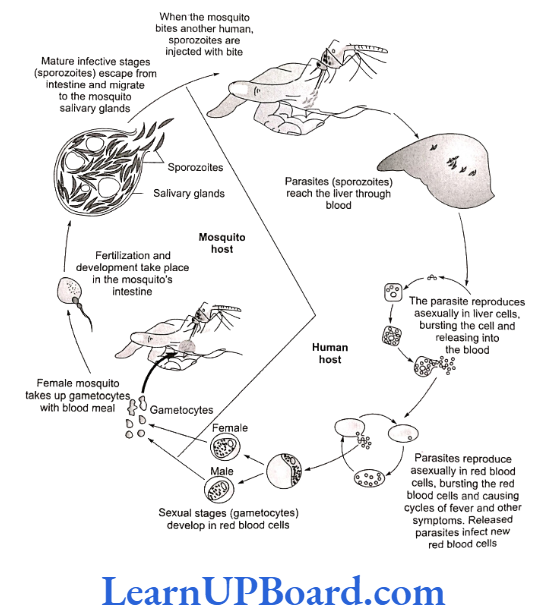
” common diseases in humans”
- During mosquito bite, these gametocytes are ingested.
- They fertilize in mosquito’s stomach and develop into sporozoites which localize in the salivary glands of the mosquito.
- These sporozoites enter the human bloodstream on a subsequent mosquito bite and, thus, complete the cycle.
- The onset may be insidious with abdominal pain, nausea, dry cough, and malaise. Rarely it may be acute and with fever and chills.
- In the early stage, fever may be persistent for several days. But soon it develops into a synchronous periodicity.
- A classical attack of fever has a chill, rise in temperature to 40-41°C, headache, and myalgia.
- This is followed by several hours of profuse sweating and fall in temperature.
- In vivax and ovale malaria, these paroxysms occur every 48 h (benign tertian) whereas in malariae, these occur every 72 h (quartan).
- In falciparum malaria, the temperature is usually persistently elevated or may progress to 48-hour cycle (malignant tertian malaria).
- These cycles may be repeated in case of benign tertian malaria due to exo-erythrocytic phase.
- Liver is moderately enlarged and tender. Spleen is often palpable in acute attack. It is soft to firm and occasionally tender.
- Rarely jaundice may occur.
- Malarial parasites may be visible on the peripheral smear examination.
- Malarial parasites can also be demonstrated on bone marrow examination and by splenic puncture.
- The treatment of malaria includes drugs such as Daraprim, Chloroquine, and Quinine (derived from the bark of Cinchona tree).
- Amoebiasis
- Amoebiasis is caused to man by protozoan Entamoeba histolytica.
- It is also known as amoebic dysentery. Entamoeba histolytica was first discovered by Lambl (1859).
- Friedrich Lösch, a Russian zoologist, in 1875, re- discovered this protozoan in the feces and intesti- nal ulcers of dysentery patients and succeeded in transferring it to puppies.
- Entamoeba histolytica is a microscopic endopara- site of man and is commonly found harboring the lumen of the upper part of large intestine, i.c., the colon.
- It invades the mucosa and sub-mucosa of the intestinal wall and causes amoebic dysentery or amoebiasis.
- The trophozoites of the parasite make their way deep by eating through the mucosa of the intestinal wall.
- Here they multiply by binary fission and spread rapidly outward to form flask-shaped ulcers containing cellular debris, lymphocytes, blood corpuscles, and bacteria.
- This causes the formation of abscesses in the intestinal wall.
- Penetration into the sub-mucosa by trophozoites is made possible by histolysis as well as cytolysis.
- The mechanism involves the dissolution and necrosis of tissues and cells by a proteolytic enzyme of the nature of histolysin secreted by trophozoites themselves.
- As the sub-mucosa is eroded by the trophozoites, the ulcers burst and the blood capillaries rupture.
- The blood and ulcer contents pour into the lumen of the intestine and pass outside with stool.
- This characterizes the amoebic dysentery or amoebiasis.
- The stool of a dysenteric person is usually acidic and consists of swarms of Entamoebae as well. Person suffering from amoebic dysentery has repeated blood-mixed, slimy, foul-smelling motions.
- Sometimes, the trophozoites make their way through blood circulation into the brain, liver, spleen, lungs, and gonads.
- Here also they destroy the tissues and cause the formation of abscesses (cavities containing pus).
- Within the liver, the trophozoites cause severe lesion affecting the metabolic activities.
- The formation of abscesses in brain usually proves fatal.
- It mainly occurs by the ingestion of tetra-nucleated cysts in food or drinks.
- Diagnosis consists of microscopical detection of trophozoites or cysts in fecal smears.
- The presence of white, stone-shaped “Charcot- Leyden” crystals in feces suggests E. histolytica infection.
- The treatment of amoebic dysentery is not very difficult, but permanent cure is sometimes hard to achieve as relapses do occur.
- For temporary relief, an alkaloid called Emetine is effective.
- A synthetic derivative called Dehydroemetine is equally effective.
- The most significant advancement in the treatment of amoebiasis has been the use of Metronidazole and Tinidazole as amoebicides.
- It is very active against both intestinal and extraintestinal amoebiasis.
- The prevention of infection is entirely a matter of hygiene, both personal as well as municipal.
- Giardiasis (diarrhea)
- It is also known as “backpacker’s disease” because the travelers are most vulnerable to this disease.
- It is caused by a zooflagellate protozoan named Giardia intestinalis.
- It is the first human parasitic protozoan known. It lives in the upper parts (duodenum and jeju- num) of human small intestine.
- It is found all over the world.
- The parasites perch over the living cells of intestinal wall by means of their adhesive discs.
- They absorb nourishment from the food passing through intestine, and grow and multiply through binary fission.
- The large number of parasites interfere with di- gestion and absorption of food.
- This causes epigastric pain, abdominal discom- fort, diarrhea, headache, and, sometimes, fever.
- The disease caused by Giardia is popularly known as giardiasis or diarrhea (watery and frequent stools).
NEET Biology Notes Human Health And Disease Diseases Caused By Helminthes
- Ascariasis
- It is caused by Ascaris lumbricoides which is cosmopolitan in distribution.
- It is an endoparasite of the small intestine of human beings, but also infects pigs and cattle.
- It is more common in children because they generally have the habit of eating soil and clay, which may be infected by the eggs of Ascaris.
- The food of the worm consists of semi-digested food of the host, the blood, and the fluid of the alimentary canal of the host.
- The worm ingests food with the help of suctorial pharynx.
- There is no secondary host in the life cycle of this parasite.
- Since a large number of adult Ascaris worms normally infest a single host, they obstruct the intestinal passage and, thereby, cause abdominal discomforts such as colic pains.
- The patient may also suffer from impaired digestion, diarrhea, and vomiting.
- In children, where the Ascaris infection is quite common, mental efficiency is affected and body growth is retarded.
- The disease can best be treated by administering antihelminthic drugs such as oil of chenopodium, Alcopar, Bendex, Dewormis, and Zental.
- Since the main source of infection is the pollution of soil, water, and vegetables, utmost care should be taken in the dispersal of human fecal matter.
- Vegetables, as a rule, should be washed properly before eating.
- Parents should see to it that their children do not take to the habit of eating soil.
- Filariasis
- Wuchereria (W. bancrofti and W. malayi), the filarial worms, cause a slowly-developing chronic inflammation of the organs in which they live for many years, usually the lymphatic vessels of lower limbs. The disease is called elephantiasis or filariasis.

- The genital organs are also often affected, resulting in gross deformities.
- The pathogens are transmitted to a healthy person through the bite of female Culex mosquito vectors.
NEET Biology Notes Human Health And Disease Disease Caused By Fungi
- Dermatophytes are a group of closely related fungi.
- These infect the skin, hair, and nails and cause a variety of clinical conditions collectively called as dermatophytoses or tinea or ringworm.
- Dermatophytes include three genera:
- Trichophyton: It infects skin, hair, and nails.
- Microsporum: It attacks hair and skin but, usually, not the nails.
- Epidermophyton: It infects skin and nails, but not the hair.
- Thus, the main symptoms of the disease are the appearance of dry, scaly lesions on various parts of the body such as skin, nails, and scalp.
- These lesions are accompanied by intense itching.
- In tinea cruris or dhobie itch, the groin and perineum are involved.
- In tinea barbae, the bearded areas of the face and neck are involved.
- Tinea pedis or athlete’s foot is the ringworm of the foot and tinea capitis is the ringworm of the scalp.
- Heat and moisture help these fungi to grow in the skin folds such as those in the groin or between the toes.
- The infection of ringworm is usually acquired from soil or by using towels, clothes, or combs of infected persons.
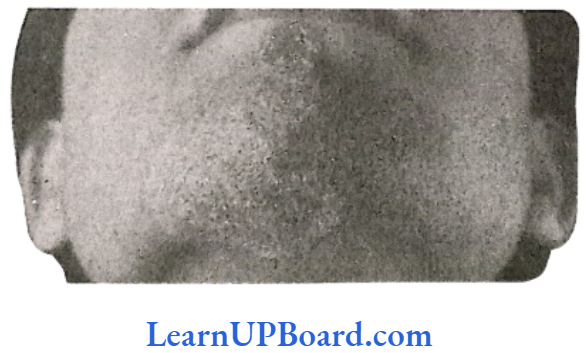
NEET Biology Notes Human Health And Disease Immunity
- Everyday we are exposed to a large number of infectious agents.
- However, only a few of these exposures result in disease. Why?
- This is due to the fact that the body is able to defend itself from most of these foreign agents.
- This overall ability of the host to fight the disease causing organisms conferred by the immune system is called immunity.
- The organs of the immune system include primary lymphoid organs such as bone marrow and thymus where immature lymphocytes differentiate into antigen-sensitive lymphocytes and secondary lymphoid organs such as lymph nodes and spleen which provide sites of interaction of lymphocytes, and antigens.
Lymphoid Organs
Lymphoid organs are those organs where the maturation and proliferation of lymphocytes take place.
Types of Lymphoid Organs
Lymphoid organs are of two types:
- Primary lymphoid organs (central lymphoid organs)
- These are those organs where T-lymphocytes and B-lymphocytes mature and acquire their antigen- specific receptors.
- Thymus and bursa of Fabricius of birds are primary lymphoid organs.
- The bone marrow of mammals is considered equivalent to the avian bursa of Fabricius.
- All cells of the immune system are initially derived from the bone marrow.
- They form through a process called hematopoiesis.
- During hematopoiesis, the bone marrow-derived stem cells differentiate either into mature cells of the immune system or into precursors of cells that migrate out of the bone marrow to continue their maturation elsewhere.
- Bone marrow produces B-cells, NK cells, granulocytes, and immature thymocytes, in addition to red blood cells (RBCs) and platelets.
- Thymus is also called the “throne of immunity” or the “training school of T-lymphocytes.”
- Its function is to produce mature T-cells.
- Immature thymocytes/prothymocytes leave the bone marrow and migrate into the thymus.
- Through a remarkable maturation process, sometimes referred to as thymic education, T-cells that are beneficial to the immune system are spread while those T-cells that might evoke a detrimental auto-immune response are eliminated.
- Mature T-cells are then released into the blood-stream.
- Secondary lymphoid organs (peripheral lymphoid organs)
- After maturation, B-lymphocytes and T-lymphocytes migrate blood via vascular and lymphatic systems to the secondary lymphoid organs where they undergo proliferation and differentiation.
- Secondary lymphoid organs are lymph nodes, spleen, tonsils, Peyer’s patches of the small intestine, appendix, and mucosal associated lymphoid tissue (MALT).
- MALT is located within the lining of major tracts (digestive, respiratory, and urinogenital).
- It constitutes about 50% of the lymphoid tissue in human body.
- In secondary lymphoid organs such as lymph nodes and spleen, there are two types of areas:
- Thymus-dependent area: It is any part of peripheral lymphoid organs populated by T-lymphocytes, e.g., paracortex of lymph nodes and center of Malpighian corpuscle of spleen.
- Thymus-independent area: It is rich in B-lymphocytes.
” human health and welfare “
Spleen
- Spleen is an immunologic filter of the blood.
- It contains B-cells, T-cells, macrophages, NK-cells, and RBCs.
- In addition to capturing foreign materials (antigens) from the blood that passes through spleen, migratory macrophages bring antigens to the spleen via blood- stream.
- An immune response is initiated when the macrophages present the antigen to the appropriate B- or T-cells.
- This organ can be thought of as an immunological conference center.
- In the spleen, B-cells become activated and produce large amounts of antibody.
- Also, old RBCs are destroyed in the spleen.
Lymph Nodes
- Lymph nodes function as an immunologic filter for the body fluid known as lymph.
- Lymph nodes are found throughout the body.
- Composed mostly of T-cells, B-cells, and macrophages, the nodes drain fluid from most of our tis- sues.
- Antigens are filtered out of the lymph in the lymph node before returning the lymph to circulation.
- In a similar fashion as the spleen, the macrophages that capture antigens present these foreign materials to T- and B-cells, consequently, initiating an immune response.
- The lymphoid tissue located within the lining of major tracts (respiratory, digestive, etc.) is called MALT.
Types of Immunity
There are two types of immunities against pathogens: Non-specific innate immunity and specific acquired immunity.
Non-specific innate immunity
It includes all those defense elements with which an individual is born, i.e., always available to protect a living body. It can be further of four categories:
- Anatomic barriers or physical barriers
- Skin
- Skin is the physical barrier of body.
- Its outer tough layer, stratum corneum, prevents the entry of bacteria and viruses.
- Mucous membrane
- Mucus secreted by mucous membrane traps the microorganisms and immobilizes them.
- Microorganisms and dust particles can enter the respiratory tract with air during breathing; these are trapped in the mucus. The cilia sweep the mucus loaded with microorganisms and dust particles into the pharynx (throat).
- From the pharynx, it is thrown out or swallowed for elimination with the feces.
- Mucous membrane over the mucosa of stomach protects it from the corrosive action of HCI.
- Skin
- Physiological barrier
- Oil secreted by the oil glands and sweat secreted by the sweat glands make the surface of the skin acidic (pH 3-5). This does not allow microorganisms to establish on the skin. Some friendly bacteria also occur on the skin, which release acids and other metabolic wastes that check the growth of pathogens. Sweat also contains an enzyme named lysozyme that destroys the cell walls of many bacteria.
- Lysozyme is also present in tears and checks eye infections.
- It is also present in the saliva which kills bacteria present in food.
- Highly acidic gastric juice also kills harmful bacteria in the stomach.
- Bile checks the growth of foreign bacteria in the intesting.
- The mesh of fine hair in our nostrils filters out particles which may carry pathogens. Nasal secretions also destroy the harmful foreign germs with their lysozyme.
- Certain bacteria normally live in vagina. These bacteria produce lactic acid. Lactic acid kills the foreign bacteria.
- Interferon:
- These are glycoproteins released by the cells in response to a viral infection. which they help to combat.
- These interferons do not kill/inactivate the virus, but make the unattacked cells less susceptible so that they are prevented from the attack of virus.
- Interferons were discovered by Isaac and Lindemann.
- They also prevent the virus from taking over the cellular machinery.
- Interferon proteins have proved to be effective in treating influenza and hepatitis, but their role in cancer treatment is doubtful. (Interferons are now included in cytokine barrier.)
- Phagocytic barrier
The internal defense is carried on by white blood corpuscles (WBCs), macrophages, inflammatory reaction, and fever.- WBCs (leucocytes)
- Leucocytes in general and lymphocytes in particular are capable of squeezing out through the wall of blood capillaries into extravascular regions.
- This phenomenon is called diapedesis.
- Leucocytes protect in different ways.
- Lymphocytes: These can produce plasma cells which secrete antibodies to provide immunity.
- Monocytes: These are phagocytic in action.
- Eosinophils: These can attach themselves to parasitic forms (mostly in case of helminths) and cause their destruction by liberating lysosomal enzymes on their surface.
- Neutrophils: These eat up harmful germs and are, therefore, phagocytic in nature.
- Macrophages
Macrophages are formed by the enlargement of monocytes. These are large cells which are phagocytic in nature.
- WBCs (leucocytes)
- Inflammatory barrier:
- When microorganisms such as bacteria and viruses enter the body tissue through some injury, these produce some toxic substances which kill more cells.
- These broken cells also release some material which attracts the mast cells.
- The mast cells release histamine.
- Histamine causes the dilation of capillaries and small blood vessels surrounding the injury and increases the permeability of capillary walls.
- More blood flows to the area making it red and warm.
- The fluid (plasma) leaks out into the tissue spaces, causing its swelling.
- This reaction of body is known as inflammatory response.
- The plasma that accumulates at the injured site dilutes the toxins secreted by bacteria and decreases their effect.
- Fever
- The inflammatory response may be in the region of the wound (localized) or it may be spread all over the body (systemic). o In systemic inflammatory response, the number of WBCs increases. Generally, the fever is caused by the toxins released by pathogens or by compounds called py- rogens (fever-producing substances).
- These compounds are released by WBC in order to regulate the temperature of the body.
- Moderate fever stimulates the phagocytes and inhibits the growth of microorganism.
- However, a very high fever is dangerous. o It is necessary to bring down fever by giving antipyretics (fever-reducing drug) and by applying cold packs.
- Thus, interferons, leucocytes, macrophages, inflammatory response, and fever form the second line of defense.
- NK cells
- NK cells are another population of large granular lymphocytes which destroys a wide variety of infectious microbes and certain spontaneously arising tumor cells.
- Unlike T-cell, these do not mature in the thymus and unlike both B- and T-cells, these lack surface molecules/antigen receptors. NK cells are present in the spleen, lymph nodes, red bone marrow, and blood.
- These cells release g-interferon which stimulates their cytolytic activity.
- These may release chemical-perforins which cause the cytolysis of the microbe or may bind to a target cell to inflict damage by direct contact.
- NK cells probably attack cells that do not display major histocompatibility complex (MHC) antigens.
- NK cells are defective or decrease in number in some cancer patients and in patients with AIDS.
- Complement system
- A complement system is a set of 30 different protein molecules always found in the blood.
- There are no cells in the system.
- With an infection, this system of molecules is activated, leading to a sequence of events on the surface of the pathogen that helps destroy the pathogen and eliminate the infection. A complement system can be activated in two main ways.
- The first and most potent way, known as classical pathway, occurs when IgG (or IgM) binds to the antigen at the surface of a cell. This exposes the Fc region of the antibody such that the first complement protein (C1) binds.
- The second means of activation, known as alternate pathway, is a part of the natural (in- nate) immune response (i.e., neither antibodies nor T-cell receptors are involved). Here, certain polysaccharides found on the surface of bacteria activate the system.
- This can occur immediately and does not require prior exposure to the molecules.
- But in either case, a cascade of events follows, in which each step leads to the next.
- At the center of the cascade are steps in which the proteolysis of a complement protein leads to a smaller protein and a peptide.
- The smaller protein remains bound to the complex at the surface of the microorganism while the peptide diffuses away.
- As a result, the membrane loses all its regulatory properties; that is to say, the cell swells and bursts.
- This final complex of molecules that causes cell lysis is termed as the membrane attack complex (MAC).
- Thus, the complement system triggers a constellation of effects that help in dealing with an infection.
- Opsonization
- Chemotaxis (attracting macrophages and neutrophils)
- Inflammation
- Lysis (rupturing membranes of foreign cells)
- Innate immunity is a non-specific type of defense that is present at the time of birth. This is accomplished by providing different types of barriers to the entry of foreign agents into our body. Innate immunity consists of the following four types of barriers.
- Physical barriers: The skin on our body is the main barrier which prevents the entry of microorganisms. Mucus coating of the epithelium lining the respiratory, gastrointestinal, and urogenital tracts also help in trapping the microbes entering our body.
- Physiological barriers: Acid in the stomach, saliva in the mouth, tears from eyes all prevent microbial growth.
- Cellular barriers: Certain types of leukocytes (WBC) of our body [such as polymorphonuclear leukocytes (PMNL-neutrophils) and monocytes] and natural killer (type of lymphocytes) in the blood as well as macrophages in tissues can phagocytose and destroy microbes.
- Cytokine barriers: Virus-infected cells secrete glycoproteins called interferons which protect non-infected cells from viral infection.
Acquired or adaptive or specific immunity
- Immune system forms the third line of defense.
- There are two components of immune system in body: Humoral immune system and cellmediated immune system. The important characteristics of immune systems are as follows:
- Specificity: Ability to differentiate between foreign molecules.
- Diversity: To recognize enormous variety of foreign molecules.
- Discrimination: Ability to differentiate between foreign and self, i.e., will respond to foreign compound and avoid response to self molecules.
- Memory: After encountering any foreign agent or microbe, immune response is evoked. It results in the formation of memory cells responsible for retaining memory. This is the basis of vaccination as the second response to the same microbe will evoke hightened immune response due to memory cells.
- Specific immunity involves two types of cells: Lymphocytes and antigen presenting cells.
- Lymphocytes
- Lymphocytes (a type of WBCs) are the main cells of immune system of the body.
- Lymphocytes, meant for immune system, are of two types: T-cells and B-cells.
- Both types of cells develop from the stem cells found in the liver of the fetus and in the bone marrow cells of the adult.
- The lymphocytes that migrate to the thymus and differentiate under its influence are called T-cells while the cells that continue to be in the bone marrow for differentiation are called B-cells.
- Final maturation of young lymphocytes occurs in lymphoid tissues such as lymph nodes, spleen, and tonsils.
- T-cells are responsible for cellular immunity. However, B-lymphocytes produce antibodies that take part in humoral immunity.
- Both T-cells and B-cells require antigens to trigger them into action but they respond differently.
- B-lymphocytes are independent of thymus and, in man, probably complete their early maturation within the bone marrow.
- These are called B-cells because these mature within the bursa of Fabricius found in the cloaca of birds.
- Antigen presenting cells
- Antigen presenting cells (APCs) are a special class of cells which process and present exogenous antigens.
- APCs include macrophages, B-cells, and dendritic cells.
- APCs are strategically located in places where antigens are likely to penetrate non-specific defenses and enter the body.
- These are the epidermis and dermis of the skin and the mucus membranes that line the respiratory, urinary, and reproductive tracts.
- The steps in processing and presenting an exogenous antigen by an APC include the following:
- Ingestion of antigen
- Digestion of antigen into peptide fragments
- Fusion of peptide fragments to MHC and its insertion into the plasma membrane. This triggers either a cell mediated immune response or a humoral mediated immune response.
- Lymphocytes
Antigens
- Antigens are foreign molecules that invade the body of an organism.
- The word “antigen” is a shortened form of “antibody generating” as they stimulate the production of anti-bodies in response to infection.
- Antigens are generally large molecules.
- The majority of them are made of proteins or polysaccharides found on the cell walls of bacteria and other cells or on the coats of viruses.
- All antigens are not the parts of microorganism.
- Other structures such as pollen grains, white of an egg, shell fish, certain fruits and vegetables, chicken, feathers of birds, blood cells from other persons or animals, drugs, and chemicals can also induce the immune system to produce antibodies.
Antibodies are an army of proteins produced by plasma cells.
” human body and diseases”
Structure of Antibody (Ig)
- Antibodies (immunoglobulins, abbreviated Ig) are glycoproteins of molecular weight 150,000-900,000 kD.
- One end of the Ig binds to the antigens (the Fab portion, so called because it is a fragment of the molecule which is antigen binding), and the other end which is crystallizable, and therefore called Fc, is responsible for effector functions.
- There are five classes (isotypes) of Ig: IgM, IgG, IgA, IgD, and IgE.
- Light chains exist in two classes: lambda and kappa. Each antibody molecule has either lambda or kappa light chains, not both.
- Immunoglobulins are found in serum and in secretions from mucosal surfaces.
- They are produced and secreted by plasma cells which are found mainly within the lymph nodes and connec- tive tissues and do not circulate.
- Plasma cells are derived from B-lymphocytes.
- These cells are responsible for secreting antibodies, i.e., immunoglobulins.
- An immunoglobulin molecule consists of two light chains (each of approximate molecular weight 25,000) and two heavy chains (each of approximate molecular weight 50,000).
- IgA exists in monomeric and dimeric forms while IgM exists in pentameric form.
- The links between monomers are made by a J chain. Additionally, IgA molecules receive a secretory component from the epithelial cells into which they pass.
- This is used to transport them through the cell and remain attached to the IgA molecule within secretions at the mucosal surface.

- The heavy and light chains consist of amino acid sequences.
- In the regions concerned with antigen binding, these regions are extremely variable, whereas in other regions of the molecule, these are relatively constant. Thus, each heavy and each light chain possesses a variable and a constant region.
- The isotype of an Ig is determined by the constant region.
- L-chains are linked with H-chains by disulfide (S-S) links. Intrachain S-S links divide H- and L-chains into domains that are separately folded.
- Antibodies are synthesized by B-lymphocytes and exist in two forms: either membrane bound or secreted.
- B-lymphocytes use membrane-bound antibody to interact with antigens.
- B-cell makes antibodies all of the same specificity, i.e., able to react with the same antigenic determinants; its progeny (as a consequence of mitotic division) is referred to as a clone.
- The clone will continue making antibody of the same specificity.
- Simultaneously, there will be lots of other clones of different specificity.
- This is known as a polyclonal response.
- Antigens have determinants called epitopes.
- Epitopes are molecular shapes recognized by antibodies, which recognize one epitope rather than the whole antigen.
- Antigens may be proteins, lipids, or carbohydrates; an antigen may consist of many different epitopes and/or may have many repeated epitopes.
- B-lymphocytes evolve into plasma cells under the influence of T-cell released cytokines.
- Plasma cells secrete antibodies in greater amounts, but do not divide.
- These exist in lymphoid tissues, not blood.
- Plasma cells make and release between 2000 and 20,000 antibody molecules per second into the blood for the next four or five days.
- B memory cells live for months or years, and are a part of the immune memory system.
- B-lymphocytes are formed within the bone marrow and undergo their development.
- They have the following functions:
- To interact with antigenic epitopes, using their immunoglobulin receptors.
- To subsequently develop into plasma cells, secreting large amounts of specific antibody.
- To circulate as memory cells.
- To present antigenic peptides to T-cells (as antigen presenting cells).
Main Functions of Free (Soluble) Antibodies
- Antibodies exist free in body fluids, e.g., serum, and membrane bound to B-lymphocytes.
- Their function, when membrane bound, is to capture antigen for which they have specificity, after which the B-lymphocytes will take the antigen into its cytoplasm for further processing.
- Free antibodies cause the agglutination of particulate matter, including bacteria and viruses.
- IgM is particularly suitable for this, as it is able to change its shape.
- Opsonization is the coating of antigen by molecules known as opsonins for which the antibody’s Fab re- gion has specificity (especially IgG).
- Even complement system takes part in opsonization especially C3b molecule.
- This facilitates subsequent phagocytosis by cells possessing an Fc receptor, e.g., neutrophil (polymorphonuclear leucocytes or polymorphs).
- Hence, opsonization is the process that facilitates the phagocytosis of antigen.
- Thus, it can be seen that in opsonization and phagocytosis, both the Fab and the Fc portions of the immunoglobulin molecule are involved.
- Neutralization of toxins released by bacteria, e.g., tetanus toxin is neutralized when specific IgG antibody binds, thus, preventing the toxin binding to motor end plates and causing persistent stimulation, manifest as sustained muscular contraction which is the hallmark of tetanic spasms.
- Other B-cells circulate as memory cells.
- This applies particularly to IgG.
- B-cells divide, forming plasma cells and B memory cells.
- In case of viruses, antibodies can hinder their ability to attach to receptors on host cells. Here, only Fab is involved.
- Antibodies against bacterial cilia or flagella will hinder their movement and ability to escape the attentions of phagocytic cells.
- Mucosal protection is provided mainly by IgA, and to a lesser degree, by IgG.
- IgA acts chiefly by inhibiting pathogens from gaining attachment to mucosal surfaces.
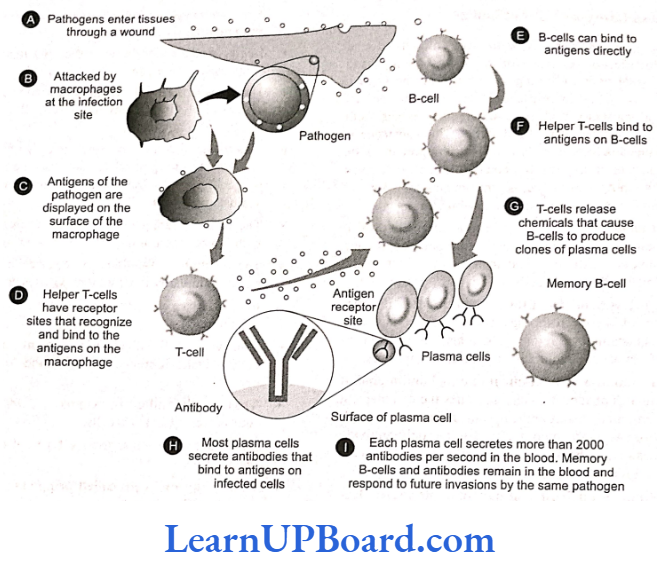
- As a consequence of antigen (e.g., parasitic worms) binding to specific IgE attached to the mast cells by their receptor for IgE, there is a release of mediators from the mast cells.
- This leads to the contraction of smooth muscle, which can result in diarrhea and expulsion of parasites.”
- Precipitation of soluble antigens by immune complex formation
- Consist of antigen linked to antibody.
- Depending on the ratio of antigen to antibody, these can be of varying size.
- When fixed at one site, these can be removed by phagocytic cells.
- These may also circulate prior to localization and removal, and can fix complement.
- Antibodies bind to organisms via their Fab region.
- Large granular lymphocytes (NK cells) attach via Fc receptors and kill these organisms not by phagocytosis but by the release of toxic substances called perforins.
Five Classes (Isotypes) of Antibodies
- IgA forms 15% of total antibody count. It is found in the mucous secretions of the respiratory tract and the upper parts of the digestive tract and the vagina. It is also found in colostrum. Colostrum is a golden liquid substance that a nursing mother expels from her breasts 24-48 h after delivery. This substance is produced before the milk and is very important in the transfer of antibodies to a newborn infant. IgA given by the mother in the colostrum protects the baby for about 6 months. Oimeric IgA has four paratopes.
- IgD forms less than 1% of the total antibodies. It appears to have a role in activating and suppressing lymphocyte activity found in large quantities in the cell walls of many B-cells. IgO has two paratopes.
- IgE is less than 1% of the total antibodies. It is mediator in allergic responses. It most importantly activates histamine secreting cells. It also appears to play a role in parasitic infection. IgE has two paratopes.
- IgG composes 75% of our immunoglobulin pool. It stimulates phagocytic cells, activates the complement system, binds neutrophils, opsonizes, and can neutralize toxins. Most importantly, it is the only antibody that can cross the placenta and confer immunity on the fetus. IgG also has two paratopes.
- IgM makes up 7-10% of our total antibodies. This is the predominant early antibody the one that first activates in an initial attack of antigen. Because of its high number of antigen-binding sites (10), it is an effective agglutinator of antigen. This is important in the initial activation of B-cells, macrophages, and the complement system.
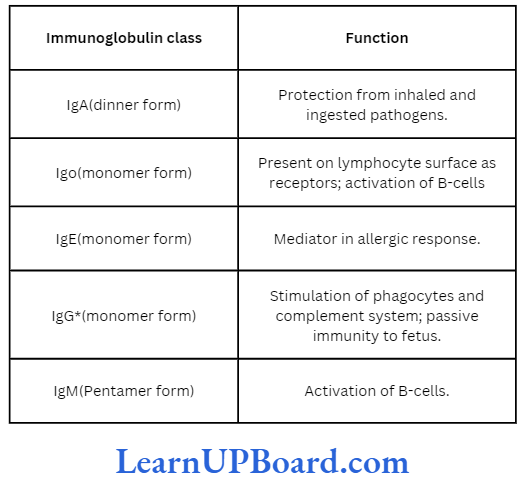
Mode of Action of T-cells to Antigens or Cell-Mediated Immunity
- T-cells are the major cells that drive cellular immunity whereas another type of lymphocyte, called as B-cells, is the principle cell involved with antibody-mediated immunity.
- T-cells are so called because they are matured in an organ called the thymus.
- The surface of a T-cell contains thousands of T-cell receptors (TCR) but for any one T-cell, all receptors are identical (monoclonal).
- This means that any one T-cell is only able to recognize a small group of related antigens, i.e., each T-cell is specific only to those antigens and is not effective against any others.
- The receptor rarely binds with an entire antigen but with a subsection of it called an epitope.
- The function of T-cells is to detect cells in the body that are internally infected with viruses and bacteria. Intra-cellular pathogens do this by sampling the contents of cells.
- Two types of T-cells sample different populations of cells and take different action when they detect an antigen.
- These are the “killer” or cytotoxic (CD8+) T-cells and the “helper” (CD4+) T-cells.
- CD8+ and CD4+ describe the types of receptors that each carries.
- A third type of T-cells called “suppressor” T-cells also uses the CD8+ receptor.
- Almost all cells in the body express a protein called the MHC protein.
- The function of MHC is to present antigens to T-cells. MHC has a slit in it, shaped like a letter box, and the
- cell pushes antigens through this slit.
- T-cell receptors plug onto the MHC molecule and try to bind with the presented antigen.
- MHC comes in two major varieties: MHC class 1 and MHC class 2.
- MHC class 1 is present on almost all nucleated cells and it is the job of killer T-cells to bind to antigens. presented in this way.
- When a match is found, the killer T-cell latches onto the infected cell and destroys it.
- MHC class 2 is present only on a population of cells known as APC.
- These include macrophages, B-cells, and dendritic cells. It is the job of helper T-cells to bind to antigens presented in this way.
- When this happens, a helper T-cell can do several things such as the following:
- It produces special messenger molecules called cytokines. Various different cytokines send different complex signals to other cells including attracting immune system cells to the site of the infection, causing endothelial (blood vessel lining) cells to let these other cells through, and causing the immune system cells to activate themselves.
- It cooperates with complementary B-cells to get them to clone themselves and to release antibodics.
- T-cells clone themselves to increase their number.
- Helper T-cells are strongly implicated in the process of demyelination in multiple sclerosis.
- The third type of T-cells (suppressor T-cells) is involved with suppressing an immune response.
- It is not well understood how they do but they probably use several mechanisms including “programmed cell death” (apoptosis) which involves sending cytokines to other immune system cells telling them to commit suicide.
- T-cells are manufactured in the bone marrow but migrate to an organ called the thymus where they are matured via a process called affinity maturation which removes those which are active against body’s own antigens (auto-reactive).
- Selection for particular T-cells is dealt with in the entry on the thymus.
- Helper T-cells are CD4 cells that become activated when they encounter the antigens now displayed on the macrophage surface.
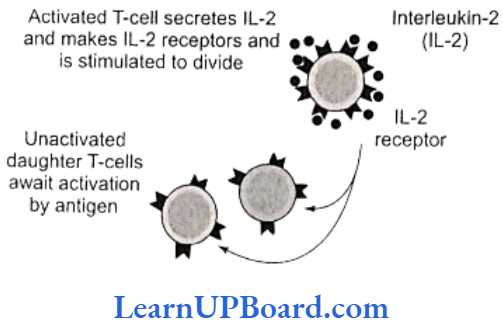
Clonal Selection and Primary and Secondary Immune Responses
- Each B- and T-lymphocyte displays on its surface a specific receptor; the number of cells expressing a given receptor is rather small.
- In case of a B-cell, this receptor is the antibody produced by that cell.
- When this receptor interacts with the antigenic determinant specific to it, the lymphocyte becomes activated and divides to form a clone of cells.
- These cells are also transformed into effector cells, i.e., antibody producing B-cells and T cytotoxic cells.
- This phenomenon is called clonal selection, where all cells in a given T- or B-cell clone are derived from a single parental cell and exhibit the same specificity for antigenic determinant.
- But some activated lymphocytes develop into long lived memory cells and do not produce antibodies or kill infected cells.
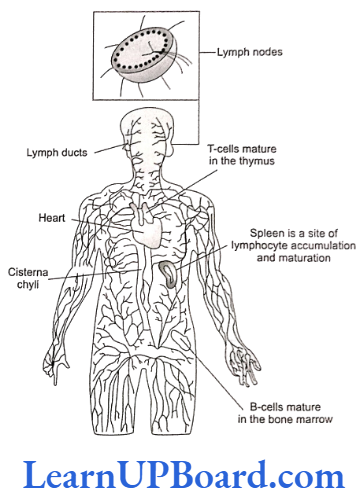
- The immune response mounted as a result of the first encounter of an animal with an antigen takes relatively longer, is feeble, and declines rapidly.
- This is known as primary immune response.
- But a subsequent encounter of this animal with the same antigen results in a hightened immune response much more rapidly.
- This is referred to as secondary immune response or anamnestic response.
- The secondary response is due to the memory cells that were produced during primary response; it lasts much longer than primary response.
- This is why a person surviving a disease such as chicken pox or measles becomes immune to subsequent attacks of the same disease.
” diseases of the human body”
Development of Immunity
A person may develop immunity in three ways:
- Vaccination: It is a technique to develop immunity without infection. Weakened or dead pathogens (attenuated) or parts of pathogens are injected into a person who is required to be made immune. The pathogens given in a vaccine are unable to cause the disease but are sufficient to stimulate the formation of antibodies by the host’s immune system. Often 2 or 3 additional doses are needed to generate adequate immunity. These doses are called booster doses.
- Antitoxins: Antibodies that neutralize toxins produced in the body or introduced from outside are called antitoxins. Bacterial toxins are produced in the body; however, antitoxins produced from outside are prepared from snake venom and are used as a remedy for snake bite.
- Immunity through diseases: Some diseases such as mumps, measles, and smallpox produce lifelong immunity. Hence, these diseases do not appear again.
Types of Immunity
There are two main types of immunity: Inborn or innate and acquired or adaptive.
- Inborn or innate immunity: This type of immunity is inherited by the organism from his parents and it protects him from the birth till the end of life. Example: Human beings have inborn immunity against distemper (a fatal disease of dogs).
- Acquired or adaptive immunity: This immunity is acquired in lifetime. It is of two types: Active or natural and passive or artificial.
- Active immunity: When an organism’s own cells produce antibodies, it is called active immunity. It develops when a person suffers from a disease or gets vaccination for a disease.
- Passive immunity: In passive immunity, the antibodies are produced in some other organisms (e.g., vertebrates) in response to the given antigen. These antibodies are then injected into the human body at the time of need. This is known as inoculation. For example, persons infected by rabies, tetanus, Salmonella (causes food poisoning), and snake venom are given sufficient amount of antibodies so that they can survive.
- Passive immunity provides immediate relief while active immunity requires some time for the formation of antibodies.
- There is another form of passive immunity. Nursing mothers transfer antibodies prepared in their body to the infants in their milk. Bottle-fed infants do not get this benefit. After a few weeks, infants’ own immunity system starts working.
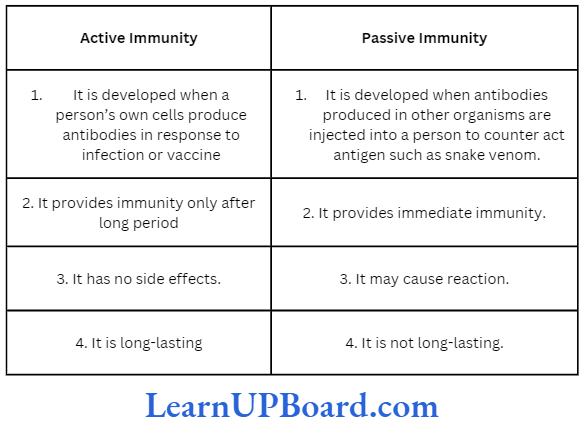
History of Vaccination and Immunization
- In vaccination, weakened or dead pathogens, or portions of pathogens, are injected into a person who is required to be made immune.
- Pathogens given in a vaccine are unable to cause the disease but are sufficient to stimulate the formation of antibodies by host’s cells.
- The process of vaccination was initiated by Edward Jenner in 1790.
- He observed that milkmaids did not contract smallpox apparently because they were exposed to a similar but milder form of disease called cowpox.
- Edward Jenner infected James Phipps, a healthy boy of about 8 years, first with cowpox and two months later, he infected the boy with smallpox.
- The boy did not suffer from smallpox.
- Jenner proposed that an induced mild form of a disease would protect a person from a virulent form (which has ability to damage the host).
- He used the term vaccine (in Latin Vacca means “cow”) and the term vaccination for protective inoculation.
- Edward Jenner was the first to discover a safe and effective means of producing artificial immunity against smallpox.
- Thus, once vaccination is done, the individual is protected from the disease.
- Vaccination develops acquired immunity.
- Pasteur confirmed Jenner’s findings and produced vac- cines for other diseases such as anthrax, rabies, and chicken cholera.
- In 1891, another daring step was taken which added to the growing understanding of immunology.
- A little girl lay dying of diphtheria.
- Her physician, Emil von Behring, decided to gamble on her life.
- He infected sheep with diphtheria bacteria and waited for some time.
- He then withdrew some blood from the sheep and separated the serum by allowing it to clot.
- He injected the serum into the patient.
- Within a few hours, she began to recover dramatically. A new method of treatment-passive immunity had been discovered.
- von Behring was awarded the Nobel Prize for this work.
- Passive immunization is the practice of taking antibodies produced by a vertebrate, in response to deliberate infection, and transferring them to a different organism by injection.
- For instance, persons infected by rabies or Salmonella (that causes food poisoning) are likely to succumb to the disease as they would not be able to produce sufficient amounts of antibodies quickly.
- To avert death, such persons are inoculated with anti-bodies produced in the plasma of horses or cow. This provides passive immunity.
NEET Biology Notes Human Health And Disease Immune System Disorder
Improper functioning of immune system can cause, discomfort, disease, or even death. These disorders may involve the following:
- Hypersensitivity or allergy:
- Allergy means inappropriate and excessive response to common antigens.
- Substances causing allergic reaction are called allergens.
- Common allergens are dust, pollen, mold, spores, fabrics, feathers, fur, plants, bacteria, foods, heat, cold, and sunlight.
- Parthenium flower is a common allergen in India.
- Allergy mostly affects the skin and the mucous membrane.
- Hay fever affects the mucous membranes of nose, eyes, and upper respiratory tracts.
- In asthma, the lower portions of the respiratory system are severely affected.
- In eczema, the skin becomes red, followed by the appearance of minute blisters.
- During allergic reaction, there is an increased release of histamine from the mast cells.
- It causes marked dilation of all peripheral blood vessels and the capillaries become highly permeable so that large amount of fluid leaks out from the blood into the tissues.
- The blood pressure decreases drastically often resulting in the death of the individual within a short time.
- Spleen is called the “shock organ of allergy.”
- The exact nature of the substance of which a person is hypersensitive must be known before he can be properly treated.
- Some forms of allergy are as follows:
- Hay fever: In this allergic form, there are swollen, reddened, running eyes and nose. The drugs called antihistamines are of major importance in the treatment of this allergic disorder.
- Asthma: It is the sudden spasm of tissue surrounding the respiratory tract causing the narrowing of respiratory tract. The tissues surrounding the respiratory tubes in the lungs swell up and compress the tubes. Hence, there is difficulty in breathing.
- Anaphylactic shock: It is an allergic reaction involving all the tissues of the body and occurs in a few minutes after the injection of an antigen such as penicillin. Such reaction is very serious. Histamine released from ruptured mast cells causes marked dilation of all the arteries so that a large amount of fluid is passed from the blood to the tissues and there is a drastic fall in blood pressure. The affected person may become unconscious and may die within a short time.
- Autoimmunity
- Antibodies are produced against antigens but, sometimes, it may also happen that the immune system of the body goes off the track and starts behaving against the “own body” or “self.”
- This leads to a variety of diseases known as autoimmune diseases.
- This type of diseases depends on the type of “selfantigen” involved.
- When the cells act as antigens in the same body, they are called autoantigens.
- The nature of autoimmune diseases depends on the autoantigens involved.
- For example, if the autoantigens are RBCs, then the body destroys its own RBC resulting in chronic anemia; if the autoantigens are produced against acetylcholine receptors (Myasthenia gravis); if the autoantigens are liver cells, then it results in chronic hepatitis; and so on. Other autoimmune diseases are insulin-dependent diabetes, Addison’s disease, ulcerative colitis, and rheumatoid arthritis.
- Immuno deficiencies
- Severe combined immuno deficiency
- Sometimes, new-born children are without T- cells and B-cells.
- These children are highly susceptible to various infections.
- The most serious disorder of this type is a congenital disease known as severe combined immuno deficiency (SCID) in which both B-cells and T-cells are not present in the body.
- Such children are highly susceptible even to minor infections.
- In developed countries such as USA, such children are kept alive by keeping them in germ-free environments called isolation suits.
- AIDS
- It is a disorder of cell-mediated immune system of the body.
- There is a reduction in the number of helper T-cells which stimulate antibody production by B-cells.
- This results in the loss of natural defense against viral infection.
- Severe combined immuno deficiency
- Graft rejection
- Grafts of kidney, heart, lung, liver, etc., from one human to another are always (unless donated by an identical twin) seen by the recipient’s immune system as an antigenic and elicit immune response.
- If unchecked, this response will eventually lead to the destruction of the graft. Both CD4+ and CD8+ T-cells participate in graft rejection.
- They are responding to differences between donor and host of their class II and class I histocompatibility molecules, respectively.
- Graft-versus-host disease
- Grafts of bone marrow are used to provide, or restore, a source of blood cells for the recipient.
- If there are any histocompatibility differences between donor and recipient (and there always are some, unless the patient’s own marrow is used or that of an identical twin), then the T-cells of the donor will mount an immune response against the tissues of the recipient.
- Fortunately, graft-versus-host disease can usually be controlled with immunosuppressive drugs.
NEET Biology Notes Human Health And Disease Cancer
- Cancer is characterized by the uncontrolled multiplication of abnormal cells in the body.
- The spread of cancerous cells to distant sites via blood is termed as metastasis.
- Normally, cells show a property called contact inhibition by virtue of which contact with other cells inhibits their uncontrolled growth, but cancer cells have lost this property.
- It may be broadly classified into three major categories:
- Carcinomas are malignant growths of epithelial (ectodermal) tissues that cover or line the body organs, e.g., skin cancer, breast cancer, lung cancer, and cancer of the stomach and pancreas. (About 85% of all tumors are carcinoma.)
- Sarcomas are malignant growths arising in tissues derived from primitive mesoderm, e.g., bone tumors, muscle tumors, and cancer of lymph nodes. These are rare in human beings (about 1% of all tumors).
- Leukemias result from the unchecked proliferation of cell types present in blood and their pre- cursors in the bone marrow.
- Cancer is a complex group of diseases that can affect many different body cells and tissues.
- All cancers are characterized by the uncontrolled growth and division of cells.
- Cancer leads to a mass of cells termed as neoplasm (Gr. for new formation) or tumor.
- Abnormal and persistent cell division localized in a particular region is called benign tumor.
- Benign tumor contains well-differentiated cells, not usually dangerous.
- Tumor cells may be carried by bloodstream or lymph or may penetrate directly to the other parts of the body resulting in dangerous malignant tumors. The spread of cancerous cells to distant sites is termed as metastasis.
- Other types of cancers are as follows:
- Melanoma: Cancer of pigment cells of the skin
- Adenoma: Cancer of glands
- Myoma: Cancer of muscular tissue
- Lymphoma: Cancer of lymphatic tissue
- Glioma: Cancer of glial cells of CNS
- Oncology is the study of cancer.
- All cells carry certain cancer-associated proto-oncogenes.
- Susceptibility to cancer depends on familial factors, smoking, chemical and environmental factors, viral factor, alcohol, and dietary factors.
- Any agent that induces a cancer is carcinogenic or oncogenic agent.
- Exposure to ionizing radiations such as X rays, gamma rays, and non-ionizing UV rays is said to induce cancer.
- Chemical substances that can cause mutation are called carcinogens.
- Physical irritants can also lead to cancer such as continued abrasion of the lining of the intestinal tract by some type of food.
- In many families, there is a strong hereditary tendency to cancer.
- Viruses cause a number of specific cancers in animals.
- Tumor-producing viruses are called oncoviruses.
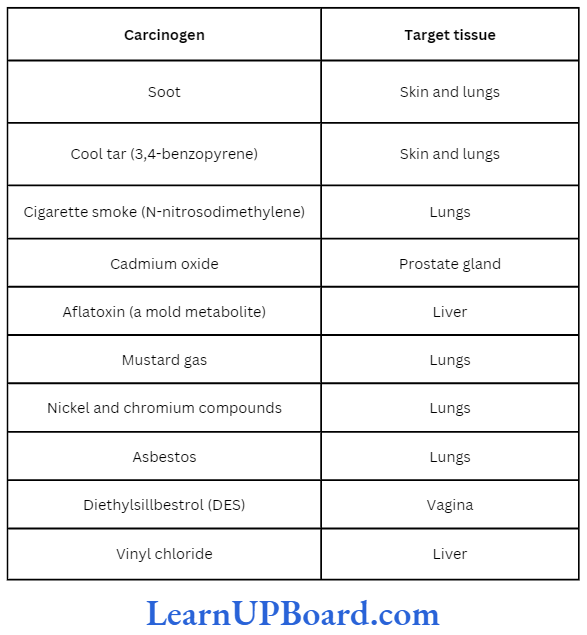
- Viruses are the second cause of cancer.
- These agents are tiny packages of nucleic acids, either DNA or RNA, that are capable of infecting cells and converting them to virus-producers.
- Although the link between viruses and cancer is strongly established for a variety of animal cancers, the relation in human cancers is less predictable.
- Clearly, the number of people infected with these viruses is much larger than the number that develops cancer.
- But evidence suggests that chronic viral infections are associated with up to one-fifth of all cancers. These include the following:
- Human T-cell leukemia virus-1 (HTLV-1): It is associated with leukemia (a malignant disease of blood-forming tissues) and lymphoma (a cancer of lymphatic tissue).
- Human immune deficiency virus (HIV): It is associated with KS, a cancer of blood vessels in the skin.
- Epstein-Barr virus (EBV): It causes infectious mononucleosis, associated with Burkitt’s lymphoma (a cancer of white blood cells), nasopharyngeal carcinoma (common in Chinese males), and Hodgkin’s disease (a lymphatic system cancer). Here, Burkitt and Hodgkin are the names of discoverers.
- Hepatitis B virus (HBV): It is associated with liver cancer.
- Human papilloma virus (HPV): It causes genital warts (benign growths) associated with the cancer of cervix, vagina, penis, and colon.
- Type 2 herpes simplex virus: It causes genital herpes, implicated in the cancer of cervix of the uterus.
- Cancer may cause a variety of minor symptoms. Any that persist for several days should be checked by a doctor. The earlier a cancer is diagnosed, the better the chance of cure. Some symptoms are as follows:
- Rapid weight loss without apparent cause.
- A scab, sore of ulcer that fails to heal within 3 weeks.
- A blemish or mole that enlarges, bleeds, or itches. Severe recurrent headaches.
- Difficulty in swallowing (persistent hoarseness of voice)
- Coughing of blood sputum (phlegm).
- Change in shape or size of testes.
- Blood in urine, with no pain on urination.
- Change in bowel habits.
- Lump or change in breast shape.
- Bleeding or discharge from nipple.
- Vaginal bleeding or spotting between periods or after menopause.
- Cells of malignant tumors duplicate continually and very often quickly and without control.

- Such an increase in the number of cells due to an in- crease in the frequency of cell division is called hyperplasia.
- Initially, malignant cells invade surrounding tissues. As the cancer grows, it expands and begins to compete with normal tissues for space and nutrients.
- Eventually, the normal tissue decreases in size (atrophies) and dies.
- Following the nearby invasion, some malignant cells may detach from the initial (primary) tumor.
- They may invade a body cavity or enter the blood or lymph, which can lead to widespread metastasis.
- Next, those malignant cells that survive in the blood or lymph invade other body tissues and establish secondary tumors.
- Finally, the secondary tumors become vascularized.
- They undergo angiogenesis, which is the growth of new networks of blood vessels.
- Any new tissue, whether it results from repairing a wound, normal growth, or tumors, requires a blood supply to deliver nutrients and oxygen.
- Proteins that serve as chemical triggers for blood vessel growth in tumor tissue are called tumor angiogenesis factors (TAFS).
- In all stages of metastasis, the malignant cells resist the antitumor defenses of the body.
- The pain associated with cancer develops when the growth puts pressure on nerves or blocks a passage-way so that secretions build up pressure.
Cancer Detection and Diagnosis
- Early detection of cancers is essential as it allows the disease to be treated successfully in many cases.
- Cancer detection is based on biopsy and histopathological studies of the tissue and blood, and bone marrow tests for increased cell counts in case in leukemias.
- In biopsy, a piece of suspected tissue cut into thin sections is stained and examined under microscope (histopathological studies) by a pathologist.
- Techniques such as radiography (use of X rays), CT (computed tomography), and MRI (magnetic resonance imaging) are very useful to the detect cancers of internal organs.
- MRI is the safest method for detection of cancer. CT uses X rays to generate a three-dimensional image of the internal structure of an object.
- MRI uses strong magnetic fields and non-ionizing radiations to accurately detect pathological and physiological changes in the living tissue.
- Antibodies against cancer-specific antigens are also used for the detection of certain cancers, e.g., Herceptin.
- Monoclonal antibodies are used for the diagnosis of breast cancer.
- Techniques of molecular biology can be applied to detect genes in individuals with inherited susceptibility to certain cancers.
- Identification of such genes, which predispose an individual to certain cancers, may be very helpful in the prevention of cancers.
- Such individuals may be advised to avoid exposure to particular carcinogens to which they are susceptible (e.g., tobacco smoke in case of lung cancer).
Treatment of Cancer
- Common approaches for the treatment of cancer are surgery, radiation therapy, and immunotherapy.
- In radiotherapy, tumor cells are irradiated lethally, taking proper care of the normal tissues surrounding the tumor mass.
- Several chemotherapeutic drugs are used to kill cancerous cells.
- Some of these are specific for particular tumors.
- Majority of drugs have side-effects such as hair loss and anemia.
- Most cancers are treated by the combination of surgery, radiotherapy, and chemotherapy.
- Tumor cells have been shown to avoid detection and destruction by immune system.
- Therefore, patients are given substances called biological response modifiers such as interferon, which activate their immune system and help in destroying the tumor.
- A common weed, Catharanthus roseus (Vinca rosea or Sadabahar), is the source of two anticancer drugs, Vincristin and Vinblastin, used in the treatment of leukemia.
AIDS
- AIDS is a deadly disease, caused by HIV, which mounts a direct attack on all cells that have a specific protein called CD4 on their surfaces.
- CD4 is found on a class of lymphocyte cells called T4- cells.
- This class includes helper T-cells, which is why HIV destroys the body’s population of helper T-cells.
- CD4 receptors are also found on macrophage surfaces, and as a result, macrophages also become infected with HIV.
- Much of the HIV transmission from one individual to another is thought to occur within macrophages passed as a part of body fluids.
- Macrophages, thus, act as HIV factory.
- A simplified definition of AIDS includes anyone infected with HIV and having a T4 lymphocyte count under 200/mm3 of blood. (Normally, the T4 count would be about 1200/mm3.)
- AIDS was first recognized in June 1981 as a result of reports from the Los Angeles area (USA) to the Center for Disease Control and Prevention (CDC) of several cases of a very rare type of pneumonia caused by a fungus.
- The pneumonia, called Pneumocystis carinii pneumonia (PCP), occurred among homosexual males.
- At about the same time, the CDC also received reports from New York and Los Angeles concerning an in- crease in the incidence of (KS) amongst homosexual males.
- AIDS was first recognized in the USA in 1981.
- In 1984, American and French scientists independently identified the agent as a virus.
- Americans named it HCLV-III (human cell leukemia virus-3).
- The name human immune deficiency virus is now preferred.
- There are two types of HIV, namely HIV-1 and HIV- 2; the most common virus currently associated with AIDS is HIV-1.
- A virus called the Simian immuno deficiency virus (SIV) found in the blood of wild African green mon- key is similar to HIV-2.
- The genome of HIV consists of two identical molecules of single-stranded RNA and is said to be diploid.
- HIV consists of a core RNA with reverse transcriptase surrounded by a protein coat.
- The protein coat around the core consists of a protein called P24.
- Outside this protein coat is a layer composed of another protein called P17.
- The outermost envelope consists of a phospholipid bilayer studded with glycoproteins (GP120 and GP41).
- HIV is a retrovirus; using the enzyme reverse transcriptase, it can synthesize DNA from RNA.
- Once HIV produces DNA from its RNA, the DNA is integrated into the host cell’s DNA.
- There it can remain dormant, giving no sign of its presence, or it can take over the host cell’s genetic machinery to produce more viruses.
- The major cell infected by HIV is the helper T-lymphocyte that bears the CD4 receptor site.
- The attachment of the virus of CD4 receptor site occurs with the help of GP120 on the protein coat of the virus.
- HIV enters body cells by receptor-mediated endocytosis.

- The receptor of docking protein that permits HIV entry is the CD4 molecule on the surface of T4 cells, although other cellular factors, not yet understood, must also contribute.
- With time, the number of T4 cells, mainly helper T- cells, declines due to the death of infected cells.
- The result is progressive collapse of the immune system.
- Since cytokines secreted by helper T-cells normally stimulate the activity of monocytes, neutrophils, and macrophages, non-specific defense mechanisms are also depressed.
- The person becomes susceptible to opportunistic infections-invasion of normally harmless microorganisms that now proliferate wildly because of the defective immune system.
- Besides PCP, AIDS victims have persistent diarrhea and are especially susceptible to toxoplasma infections (tuberculosis), leukoplakia (whitish patches on mucous membranes primarily due to yeast infections), cytomegalovirus (leading to blindness and dementia), and Herpes simplex, among many other bacterial and fungal infections.
- The AIDS virus infects macrophages, brain cells (where HIV-infected cells may release toxins that dis- rupt and kill other brain cells), as well as T4 cells. The most common HIV-related opportunistic infec- tions are PCP and KS (a cancer of the skin).
- The clinical symptoms of AIDS usually appear when the T-lymphocyte level falls below 200/mm3.
- The median time for survival after the diagnosis of AIDS is 2 years.
- Some people with AIDS live for 6 or more years while others survive for a few months only.
- Some weeks after infection with HIV, the host develops antibodies against several proteins in the virus.
- Antibodies normally are protective because they help eliminate an intruder.
- In the case of AIDS virus, this is not necessarily the case because HIV can remain hidden inside body cells, unavailable to form antigen-antibody complexes.
- HIV may also escape detection by cytotoxic T-cells, natural killer cells, and phagocytes.
- The virus further evades immune defenses by undergoing rapid antigenic changes in its surface proteins. Moreover, infected cells displaying viral antigens can fuse to uninfected cells and spread the virus that way.
- In rare cases, a person may harbor HIV without forming antibodies against it.
- Thus, a standard blood test that detects antibodies would be negative.
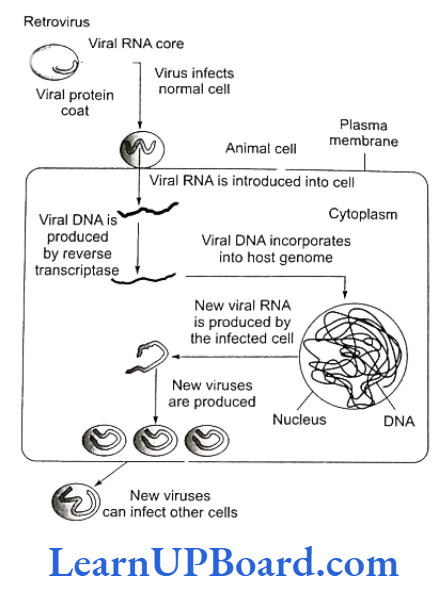
- The presence of nucleic acids from HIV can still be detected using a method called the polymerase chain reaction (PCR).
- Once the host is infected by HIV, a detectable antibody response occurs in most cases within 6-8 weeks.
- HIV antibodies can be detected by the ELISA test (enzyme-linked immunosorbent assay).
- A positive ELISA should be confirmed using another test called the western blot test.
- Although HIV has been isolated from several body fluids, the only documented transmissions are from blood, semen, or vaginal secretions or by way of breast milk from a nursing mother to her baby.
- The virus is found free and in macrophages in these fluids.
- HIV is transmitted by sexual contact most commonly. It is also effectively transmitted through the exchanges of blood, e.g., by contaminated hypodermic needles, contact with open wounds, or using the same razor blade for shaving.
- Infected mothers may transmit the virus to their infants before or during birth.
- It does not appear that people become infected as a result of routine nonsexual contact.
- There is no known case of transmission from a mosquito bite.
- It also appears that healthcare personnel who take proper routine barrier precautions when dealing with body fluids (gloves, masks, and safety glasses) are not at risk unless the barriers fail.
- Outside the body, HIV is fragile and can easily be eliminated.
- For example, dish-washing and clothes-washing; ex- posing the virus to 135°F (56°C) for 10 min will kill HIV.
- Chemicals such as hydrogen peroxide (H2O2), rubbing alcohol, household bleach, and germicidal skin cleaner (such as Dettol) are also very effective, as is standard chlorination in swimming pools and hot tubs.
- Medical scientists are engaged in an immense effort to find a cure for AIDS.
- One of the problems in treating AIDS is that HIV can lie undetected in body cells.
- In addition, HIV can infect a variety of cells, including those in the central nervous system that are protected by the blood-brain barrier.
- Added to this is the problem of oppertunistic infec- tions, which may be very difficult to treat.
- Any therapy must overcome the problem that antiviral agents may also harm host cells.
- Thus, scientists are trying to devise strategies for disrupting specific viral activities.
- Some research centers on preventing the binding of virus to the host CD4 protein.
- Other strategies are to prevent the conversion of RNA to DNA, which is catalyzed by reverse transcriptase, to block the processing of viral proteins by specific viral enzymes, to inhibit the assembly of viruses within the host cell, and to thwart release of new viruses.
- To date, four drugs with similar action are used to inhibit HIV replication and slow the progression of AIDS.
- All are nucleoside analogs-substances that are similar to the naturally occurring nucleosides in RNA and DNA.
- They block the conversion of retroviral RNA into DNA.
- The first and still most commonly used drug to treat AIDS is AZT (azidothymidine) or Retrovir.
- Among patients taking AZT, there is a slowing in the progression of symptoms.
- The main side-effects are red bone marrow damage and anemia.
- Eventually, the virus develops resistance to the drug.
- Other drugs are DDI (dideoxyinosine), DDC (dideoxycytidine), and D4T (stavudine), which may be used in patients who do not respond to AZT or have become resistant to it.
- Doctors generally give Zidovudine and Nevirapine to HIV positive pregnant women to ensure that their babies do not carry the infection.
Prevention of AIDS
- As AIDS has no cure, prevention is the best option. Moreover, HIV infection more often spreads due to conscious behavior patterns and is not something that happens inadvertently, like pneumonia or typhoid.
- Of course, infection in blood transfusion patients, new-borns (from mother), etc., may take place due to poor monitoring.
- The only excuse may be ignorance, and it has been rightly said, “Don’t die of ignorance.”
- In our country, the National AIDS Control Organization (NACO) and other non-governmental organization (NGOs) are doing a lot to educate people about AIDS.
- WHO has started a number of programs to prevent the spreading of HIV infection.
- Making blood (from blood banks) safe from HIV, ensuring the use of only disposable needles and syringes in public and private hospitals and clinics, free distribution of condoms, controlling drug abuse, advocating safe sex, and promoting regular check-ups for HIV in susceptible populations are some such steps taken up.
- Infection with HIV or having AIDS is something that should not be hidden since then the infection may spread to more people.
- HIV/AIDS-infected people need help and sympathy instead of being shunned by society.
- Unless society recognizes it as a problem to be dealt with in a collective manner, the chances of wider spread of the disease increase manifold.
- It is a malady that can only be tackled by the society and medical fraternity acting together to prevent the spread of the disease.
Cirrhosis
- Cirrhosis refers to a distorted or scarred liver as a result of chronic inflammation.
- The parenchymal (functional) hepatocytes are replaced by fibrous or adipose connective tissue.
- The symptoms of cirrhosis include jaundice, edema in the legs, uncontrolled bleeding, and increased sensitivity to drugs.
- Cirrhosis may be caused by hepatitis (inflammation of the liver), certain chemicals that destroy hepatocytes, parasites that infect the liver, and alcoholism.
NEET Biology Notes Human Health And Disease Hepatitis
- Hepatitis refers to the inflammation of liver and can be caused by viruses, drugs, and chemicals, including alcohol. Clinically, several viral types are recognized. Hepatitis A (infectious hepatitis) is caused by hepatitis A virus and is spread by fecal contamination of food, clothing, toys, eating utensils, and so forth (feco-oral route). It is generally a mild disease of children and young adults characterized by anorexia (loss of appetite), malaise, nausea, diarrhea, fever, and chills. Eventually jaundice appears. Most people recover in 4-6 weeks. Hepatitis A virus has single-stranded RNA genome and non-enveloped capsid.
- Hepatitis B (serum hepatitis) is caused by hepatitis B virus. HBV is a 42 nm enveloped virion, containing partially double-stranded circular DNA genome. Within the core there is DNA-dependent DNA polymerase. It is spread primarily by sexual contact and contaminated syringes and transfusion equipment. It can also be spread by saliva and tears. Hepatitis B virus can be present for years or even a lifetime and can produce cirrhosis and possibly cancer of the liver. Persons who harbor active hepatitis B virus are at risk for cirrhosis and also become carriers. Vaccines produced through recombinant DNA technology (e.g., Recombivax HB-second-generation vaccine) are available to prevent hepatitis B infection.
- Hepatitis C (non-A, non-B hepatitis) is caused by hepatitis C virus. It is clinically similar to hepatitis B and is often spread by blood transfusions. Hepatitis C can cause cirrhosis and possibly liver cancer. It has enveloped virion with ssRNA.
- Hepatitis D (delta hepatitis) is caused by hepatitis D virus which has ssRNA. It is transmitted like hepatitis B. In fact, a person must be co-infected with hepatitis B before contracting hepatitis D. Hepatitis D results in severe liver damage and has a fatality rate higher than that of people infected with hepatitis B virus alone. HDV is a defective virus for which HBV is the helper.
- Hepatitis E (infectious NANB hepatitis) is caused by hepatitis E virus and is spread like hepatitis A. Although it does not cause chronic liver disease, hepatitis E virus is responsible for a very high mortality rate in pregnant women. HEV has ssRNA.
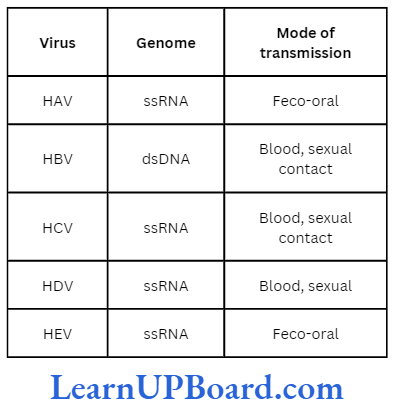
NEET Biology Notes Human Health And Disease Mental Health
- Mental illness is characterized by the following symptoms:
- Depression
- Insomnia (lack of sleep) or excessive sleeping
- Compulsive actions.
- Feeling of hopelessness
- Serious thoughts of suicide
- Unreasonable phobias
- Partial or complete loss of memory
- Self-destructive behavior, e.g., excessive gambling, drinking, drug abuse, over-eating, and extreme dieting
- Delusions (false beliefs) and hallucinations Vocational and social dysfunctioning on a day-to-day basis.
- Hallucination is a subjective disorder of sensory perception, in which one of the senses is involved in the absence of external stimulations.
Psychological Disorders
- Psychological disorders include psychosis and neurosis. Psychosis involves deeper mental disorientation due to a distorted sense of reality.
- Neurosis, on the other hand, is a maladaptive habit.
- Neurotic individual relates to the same “real world” as does the normal individual, but cannot effectively act upon it. Important psychological disorders are as follows:
- Anxiety disorders: It is associated with a range of unpleasant bodily symptoms, including palpitation, sweating, nausea, trembling, diarrhea, and muscular tension.
- Obsessive-compulsive disorders: These disorders cause total disability and affect a person’s waking hours. Affected persons manifest over whelming obsessions and compulsions. They are compelled to perform an action or an idea despite their own attempt to resist it (compulsion). The most common obsessions are violence, concern about infection by germs or dirt, and constant doubts (obsessions).
- Attention deficit disorder: It is a mental health problem among children. It occurs more in boys than in girls. As a result of this disorder, boys exhibit under achievement, behavioral problems, and a tendency to be disliked by other children.
- Mood disorders: These are the occasional bouts of high or low mood, i.e., elation and depression. Depression is a mood disorder characterized by sadness; hopelessness; low self-esteem; decline in interest, energy, and concentration; and changes in sleep pattern and appetite.
- Schizophrenia: It is characterized by (1) distorted thoughts, (2) laughing or crying at completely inappropriate times, (3) often disturbed emotions with rapid shifts from one extreme response to other, and (4) incoherent and bizarre behavior lasting for a week or more. Schizophrenics may also suffer from delusions, auditory hallucinations, and may find difficulty in handling even the simplest jobs.
- Borderline personality disorder (BPD): This disorder is an emotionally unstable personality disorder which is characterized by impulsivity, unpredictable moods, outbursts of emotion, behavioral explosions, quarrelsome behavior, and conflicts with others. BPD can be diagnosed with specific patterns of behavioral, emotional, and cognitive instability and dysregulations. These individuals are highly reactive and, generally, experience episodic depression, anxiety, and irritability. They also have problems with anger and anger expression. Relationships with other individuals are chaotic, intense but, nevertheless, hard to give up. Individuals with BPD often attempt to injure, multilate, or kill themselves, and have little sense of self since they feel empty.
Drugs and Alcohol Abuse
- Surveys and statistics show that the use of drugs and alcohol has been on the rise especially among the youth.
- This is really a cause of concern as it can result in many harmful effects.
- Proper education and guidance would enable youth to safeguard themselves against these dangerous behav- ior patterns and follow healthy lifestyles.
- Drugs that are commonly abused are opioids, cannabinoids, and coca alkaloids. The majority of these are obtained from flowering plants. Some are obtained from fungi.
Addictive Disorders
- If the body needs continuous presence of psychoactive substance within it, it is called addiction.
- Psychoactive drugs have the ability to alter the activity of nervous system.
- Different psychoactive drugs along with their category and effects are given in Table 8.5.
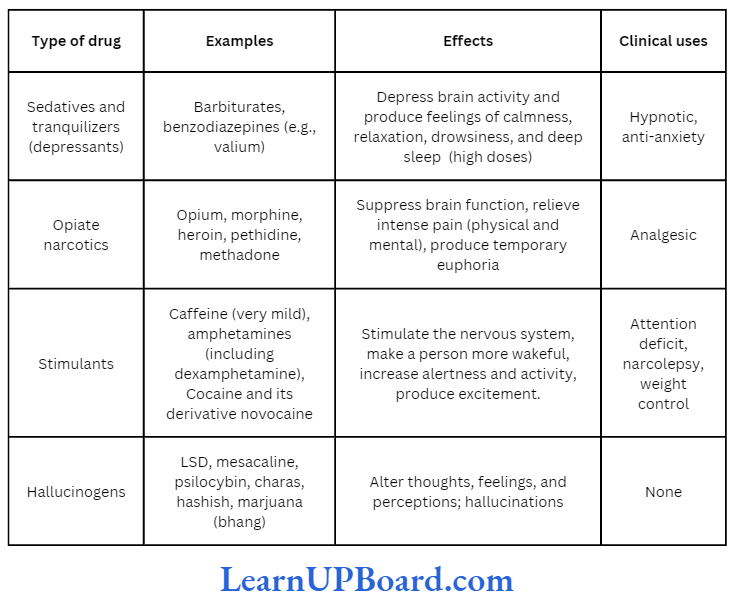
- If a person who is a habitual user abstains from a drug (abstinence), his body reacts, i.e., ceases to function normally. It is called physical dependence.
- The symptoms appearing in the body are withdrawal symptoms and range from mild tremors to convulsions, abdominal pain, diarrhea, and muscle cramps, all depending upon the type of drug abused.
- In many cases, the withdrawal symptoms may be life threatening and may need medical supervision.
Sedative-Hypnotics
- Sedatives are drugs that reduce excitement, assuage pain, and lower the physiological or functional activity leading to drowsiness or sleep.
- Hypnotics are also the drugs that induce sleep.
- Sedative-hypnotics are more or less general CNS (central nervous system) depressants. These include barbiturates and benzodiazepines.
- Barbiturates and benzodiazepines
- These are substituted derivatives of barbituric acid (a combination of melonic acid and urea, called malonyl urea) which are general depressants of all excitable cells but CNS is the most sensitive to them.
- These reduce anxiety and induce sleep. Their repeated use causes addiction.
- It results in permanent damage to brain, headache, coma, and muscular twitching.
- Sudden withdrawal causes epilepsy.
Opiates (Opioid Analgesics or Opiate Narcotics)
- Opiates or opioids are derived from opium along with their synthetic relatives.
- Drugs that relieve pain by acting on CNS are termed as analgesics. They are also called painkillers.
- Opium is the dried latex of unripe capsular fruits of poppy plant, Papaver somniferum (family Papaveraceae).
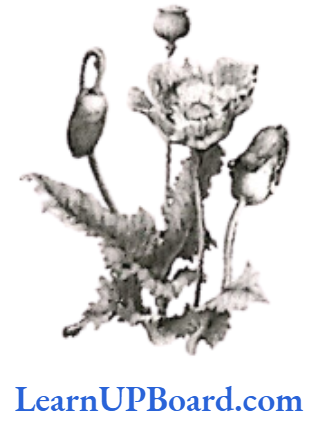
- It has heavy smell and bitter taste.
- It is smoked or eaten.
- Opioids bind to specific opioid receptors present in our CNS and gastrointestinal tract.
- Opiates have narcotic, analgesic, sedative, and astringent (that cause contraction of body parts) effects.
- They slow down respiratory activity, cause constriction of pupil of eye, decrease glandular secretions, impair digestion, and produce nausea, vomiting, and sterility.
- Opium addicts lose weight, fertility, and interest in work.
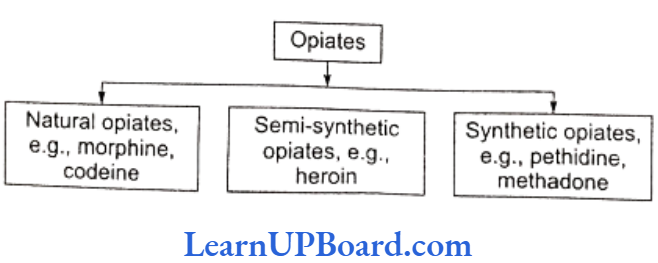
- Opium contains a number of alkaloids:
- Morphine: Serturner, a pharmacist, isolated the active principal of opium in 1806 and named it “morphine.” It is the main opium alkaloid. It is a strong analgesic and also has sedative and calming effect. Morphine depresses respiratory center and contributes to the fall in SP. It can cause bradycardia (slow heart beat), release of ADH, reduction in urine output, constipation, mild hyperglycaemia, etc. It causes addiction. Diacetyl- morphine hydrochloride is brown sugar/smack and is a more powerful analgesic than morphine.
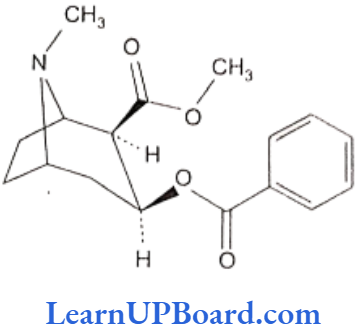
- Codeine: It is a derivative of opium (methylmorphine) which occurs naturally in opium and is partly converted in the body to morphine. It is a mild analgesic, which does not cause addiction. It is an ingredient of many medicines and cough syrups. Its prominent side effect is constipation.
- Heroin (diamorphine or diacetylmorphine): Heroin, also called as smack, is a semi-synthetic opiate which is addictive and most dangerous of all opiates. It is about three times more potent than morphine. Due to its high potency, it has been favored in illicit drug trafficking; so, it has been banned in most countries. Heroin is formed from morphine by acetylation. It is taken orally or inhaled or injected; pure drug is seldom taken. It induces drowsiness and lethargy. Heroin causes indigestion, reduced vision, decreased weight, sterility, and total loss of interest in work. Since heroin addicts are careless about syringes and needles for injection, this may cause blood poisoning, abscess formation, hepatitis-S, and AIDS. Withdrawal symptoms are unpleasant which include vomiting, diarrhea, shivering, running nose, muscular and abdominal cramps, and epilepsy.
- Pethidine (meperidine): It is a synthetic opiate which is chemically unrelated to morphine but has many similar actions. Its analgesic efficiency is almost similar to morphine and is more than that of codeine. It is equally sedative and euphoriant. It causes less histamine release and is safer in asthmatics. It has local anesthetic action. It is mostly metabolized in liver.
- Methadone: It is a synthetic opiate which is chemically dissimilar but pharmacologically very similar to morphine. It has analgesic, respiratory depressant, and constipating actions similar to morphine. Withdrawal symptoms are gradual and less severe.
Stimulants
- Drugs which stimulate the nervous system; make a person more wakeful, alert, and active; and cause excitement are termed as stimulants.
- However, addiction is psychological and the withdrawal of stimulant is followed by depression, anxiety, and restlessness. For example, caffeine, cocaine, amphetamines, etc.
- Caffeine
- It is bitter alkaloid obtained from the leaves of tea plant (Thea sinensis), seeds of coffee plant (Coftea arabica), and seeds of cocoa plant (Theobroma cacao). It is a mild stimulant and is taken as beverages (tea, coffee, cocoa, and cola drinks).
- Caffeine is CNS stimulant which provides a sense of well-being and alertness. It beats boredom, improves performance, and also acts as cardiac and respiratory stimulant; thinking becomes clear after its intake.
- It is mild diuretic (increases urine output).
- Caffeine increases contractile power of skeletal muscles.
- It inhibits the release of histamine.
- Higher doses of caffeine cause nervousness, restlessness, panic, insomnia (lack of sleep), and excitement.
- Excessive intake of caffeine also causes addiction and indigestion and disturbs renal functions.
- Cocaine
- It is a natural alkaloid obtained from the leaves of coca plant, Erythroxylum coca (family Erythroxylaceae).
- It is bitter, white, crystalline powder with vasoconstrictor properties and, hence, is a good local anesthetic.
- It interferes with the transport of neuro-transmitter dopamine.
- It is taken by snorting.
- It is a powerful CNS stimulant which induces a sense of well-being or euphoria and pleas- ure and delays fatigue.
- It also increases heart beat, blood pressure, and body temperature.
- It is smoked or injected or inhaled by addicts.
- It causes lack of sleep, loss of appetite, head- ache, convulsions, insomnia, and respiratory or cardiac failure, and may lead to mental disorder.
- Excessive dosage of cocaine causes hallucinations. Some other plants such as Atropa bellandona and Datura have hallucinogenic properties.
- Caffeine
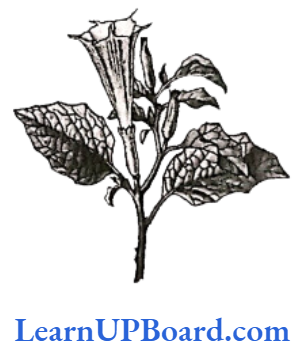
- Amphetamines
- These are synthetic drugs, commonly called pep pills, anti-sleep drugs, or speed uppers because they are CNS stimulants. These cause alertness, self-confidence, talkativeness, and increased work capacity.
- These stimulate respiratory center and cause wakefulness and postponement of sleep and, hence, are called anti-sleep drugs.
- Due to slow metabolism, the drug is found in urine for several subsequent days.
- It is one of the drugs included in the “dope test” for athletes. It suppresses hunger (anorexia) and causes addiction.
- High doses of amphetamines produce euphoria, marked excitement, sleeplessness, nausea, and vomiting.
- Amphetamines
Psychedelic Drugs (Hallucinogens)
- The drugs that change one’s mood, behavior, thoughts, and perceptions in a manner like that seen in psychosis are termed as psychedelic drugs.
- These cause hallucinations and usually make users see colors and hear sound. Hallucinogens generally produce a dream-like state by disorientation and loss of contact with reality without any true sensory stimulus.
- These are called vision-producing drugs as these pro- duce false imaginations or extreme feeling of either despair or euphoria by effecting cerebrum and sense organs.
- LSD (lysergic acid diethylamide): It is the most powerful psychedelic (hallucinogen). It is a crystalline amidated alkaloid obtained from ergot of fungus Claviceps purpurea that is a parasite on rye plant. LSD was synthesized by Hofmann (1938). It causes horrible dreams, emotional outbursts, hallucination, chronic psychosis, and severe damage to the CNS. LSD also brings about chromosomal and fetal abnormalities.
- Mescaline: It is a white powdery alkaloid, obtained from the tops (called mescals) of a small spineless cactus, Lophophora williamsii. This cactus is also called Peyote cactus. It is a low- potency hallucinogen.
- Psilocybin: It is obtained from the fruiting bodies of Mexican mushroom (fungus), Psilocybe mexicana (family: Agaricaceae). Psilocybin is a crystalline solid that may have value in psychological medicine. Its effects are similar to those of mescaline.
- PCP (phencyclidine piperidine): It has stimulant, depressant, hallucinogenic, and analgesic properties. Its higher dose may produce hypersalivation, vomiting, fever, and even coma. It is widely used in veterinary medicine to briefly immobilize large animals.
Synthetic derivatives such as DMT (dimethyl- tryptamine), DOM (dimethoxymethylamphetamine), and DMA (dimethoxyamphetamine) are also hallucinogenics. - Products of hemp plant: Known as cannabinoids, tetrahydrocannabinol (THC) is present in hemp plant, Cannabis (family: Cannabinaceae). Bhang, ganja, marijuana, etc., are the various forms in which THC is used as hallucinogen.
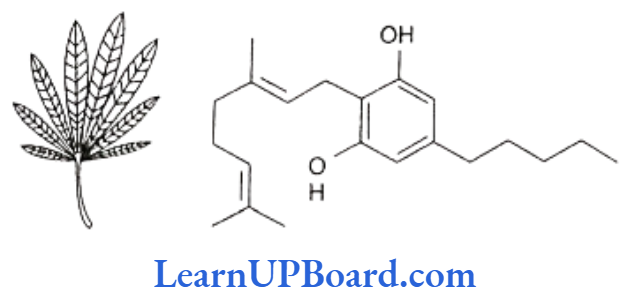
- Bhang: It is obtained from the fresh/dried leaves and flowering shoots of both male and female plants of Cannabis sativa. Bhang is generally taken orally (e.g., in the form of drink or pakora or tikki). It acts slowly.
- Ganja: It is the dried unfertilized female in- florescence of Cannabis sativa. It is smoked generally in cigarettes. It is more potent, and its effects are produced almost instantaneously.
- Charas: It is the dried resinous extract from the flowering tops and leaves of Cannabis sativa. It is most potent and smoked with tobacco. In some countries like America, charas is called hashish. Liquid hashish is called hash oil, which may contain a THC concentration of 25-60%.
- Marijuana: It is obtained from the dried flowers and top leaves of the female plants of Cannabis sativa. Its most active ingredient is delta-9-tetrahydrocannabinol (delta-9 THC). It is smoked in cigarettes.
NEET Biology Notes Human Health And Disease Alcoholism
Alcoholism is the dependency of a person on regular consumption of alcohol either in low concentration (wine, bear, etc.) or in high concentration (rum, vodka, etc.).
Effects of Alcohol on an Individual
- Effect on liver
- Absorbed alcohol is carried directly to the liver, where it becomes the preferred fuel.
- Use of moderate amounts of alcohol does not cause liver damage, provided adequate nutrition is maintained.
- However, chronic alcoholism causes the following diseases.
- Alcoholic fatty liver: The liver becomes enlarged, yellow, greasy, and firm. Hepatocytes (cells of liver) are distended by large fat globules which push the hepatocyte nucleus against the cell membrane. There is increase in fat synthesis in the liver.
- Alcoholic hepatitis: It is characterized by the degeneration of hepatocytes. The damaged (degenerated) hepatocytes are surrounded by polymorphonuclear leucocytes. These hepatocytes may be pale and swollen. Some contain dense eosinophilic masses called Mallory’s hyaline.
- Alcoholic cirrhosis: With continued alcohol intake, there is destruction of hepatocytes and fibroblasts (cells which form fibers) and stimulation of collagen protein formation.
- Cholestasis (Gr. chole-bile, stasis-standing still): It is stoppage in the flow of bile. It is characterized by jaundice, abdominal pain, and hepatomegaly (enlargement of liver).
- Effect on nervous system: These are characterized as follows:
- Will power, judgment power, and self control become reduced.
- Control on emotion reduces.
- Moral sense reduces.
- Cerebellum becomes affected which results in the loss of muscle coordination. So affected person shows staggering gait and incoherent speech.
- Inflammation of axons of neurons leads to neuritis.
- Effects on stomach:
- High doses of alcohol cause ill effect on the gastric glands of stomach. These glands secrete gastric juices in excess which cause inflammation to gastric mucosa.
- This condition is known as gastritis.
- It may also result in gastric carcinoma and peptic ulcer.
- Dilute alcohol (optimum 10%) stimulates gastric secretion (specially acid).
- Acute alcoholic intake can result in the inflammation of the oesophagus (oesophagitis) and stomach (gastritis).
- Chronic heavy drinking, if associated with violet vomiting, can produce a longitudinal tear in the mucosa at the gastrointestinal junction Mal- lory-Weiss syndrome (also called Mallory-Weiss Lesion).
- Effect on heart: Due to the deposition of alcoholic fat on the wall of blood vessels, the lumen of blood vessels becomes reduced. This increases the blood pressure and, hence, the activity of heart. The size of RBCs becomes increased but the number of RBCs, WBCs, and platelets is reduced.
- Effect on kidneys: Alcohol reduces the release of hormone ADH (antidiuretic hormone) due to which excess amount of water is released from the body. So, alcoholism greatly causes dehydration condition.
- Heavy drinking can cause an acute alcoholic myopathy characterized by painful and swollen muscles and high levels of serum creatine phosphokinase (CK).
- Alcohol increases RBC size causing mild anemia. Chronic heavy drinking can also decrease the production of WBCs. Alcohol may decrease platelet aggregation.
- Effects on the skeletal system include alternations in calcium metabolism with an increased risk for fracture and osteonecrosis (death of bone mass) of the head of femur.
- Hormonal changes include an increase in cortisol levels, inhibition of vasopressin, reversible decrease in serum thyroxine, and a more marked decrease in serum triiodothyronine (T3).
- Heavy drinking during pregnancy results in serious consequences for fetal development. The fetal alcohol syndrome (FAS) includes facial changes, poorly formed concha (cavity of pinna), small teeth with faulty enamel, and defects in atria and ventricles of heart.
- Regular intake of small to moderate amounts has been found to raise HDL or high density lipoproteins (good cholesterol) and lower LDL or low density lipoproteins (bad cholesterol) levels in the blood plasma. This may be responsible for the lower incidence of coronary artery disease in such persons. Alcohol also reduces blood sugar level which is harmful for the functioning of brain.
- Effect on immunity: Alcoholism reduces resistance to infection. Alcoholics in most cases are victims of malnutrition and are easily susceptible to diseases like pneumonia.
- Effect on family: The habit of drinking not only creates problems for the drinker but directly or indirectly affects the family and community life. Most drinkers do not think regarding the needs of their children and other members of the family.
- Effect on society: Alcoholism is invariably associated with social crimes and dissolution of moral and cultural inhibitions. Violence and other corrupt practices in the community are often directly or indirectly due to the drinking of alcohol.
Metabolism of Alcohol
- In body, the alcohol passes to the stomach.
- Some amount of it also passes to the proximal part of intestine.
- Thus, stomach and proximal part of intestine absorb this alcohol and then transfer it to blood and from blood to liver.
- In liver, alcohol is converted to acetaldehyde with the help of enzyme alcohol dehydrogenase.
- Acetaldehyde is oxidized by enzyme acetaldehyde dehydrogenase,
- It liberates heat.
- This heat is utilized in the synthesis of fat.
- The excess of fat reduces the formation of glycogen, enzymes, and structural proteins.
- This condition is known as cirrhosis.
NEET Biology Notes Human Health And Disease Tobacco Addiction
- Tobacco can be obtained from dried and cured leaves of young branches of two species of tobacco plant: Nicotiana tobaccum and N. rustica. Tobacco plant belongs to angiospermic family Solanaceae.
- The use of tobacco started in America where Red Indians started using it. It spread to Europe and other countries in early 1700s.

Tobacco Smoking and Diseases
- Cancer: About 90% victims of lung cancers are associated with smoking. Another cancer is mouth cancer due to chewing of tobacco.
- Immunity becomes weak due to regular use of tobacco.
- The use of tobacco increases male infertility.
- More adrenaline is released which increases blood pressure and heart rate. It may lead to cardiovascular diseases.
- In pregnant women, nicotine alkaloid reduces fetal growth and development.
- Carbon monoxide present in smoke combines with hemoglobin present in blood and forms carboxyhemoglobin. It greatly reduces the oxygen-carrying capacity of blood.
- Premature wrinkling may be possible.
- It is also known to cause pulmonary tuberculosis.
- Smoking causes inflammation of lung alveoli which decreases surface area for gaseous exchange and causes emphysema.
- Smoking causes irritation and inflammation of the mucosa of throat and bronchi, which causes coughing and bronchitis, respectively.
- Smoking accelerates the secretion of gastric juices, which causes gastric and duodenal ulcers.
Drugs of abuse are frequently taken with alcohol or other common medicines, e.g., aspirin and insulin. Such combination can lead to increased sedation or reduced effect of medicine or complication like hypertension.
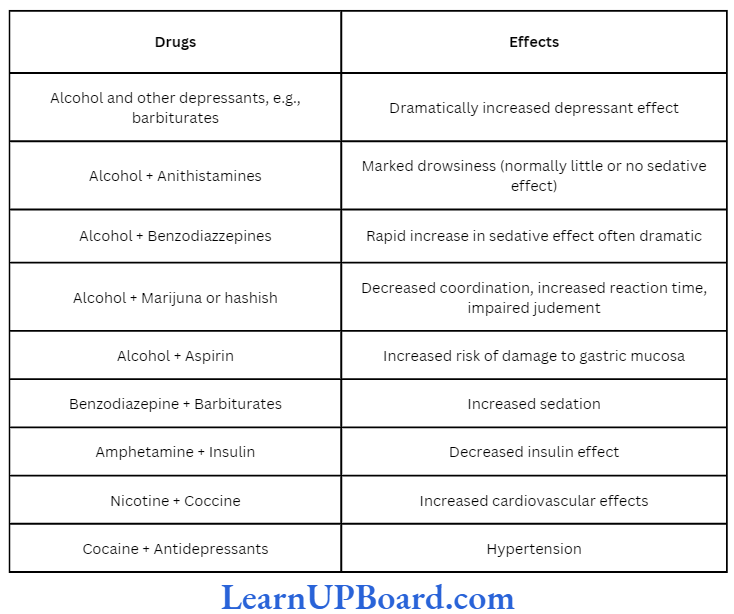
- Drugs such as barbiturates, amphetamines, benzodiazepines, lysergic acid diethyl amides (LSD), and other similar drugs, which are normally used as medicines to help patients cope with mental illnesses such as depression and insomnia, are often abused.
- Morphine is a very effective sedative and painkiller. It is very useful in patients who have undergone surgery.
- Several plants, fruits, and seeds having hallucinogenic properties have been used for hundreds of years in folk-medicine, religious ceremonies, and rituals all over the globe.
- When these are taken for a purpose other than medicinal use or in amounts/frequency that impairs one’s physical, physiological, or psychological functions, it constitutes drug abuse.
- Drug abuse is found only with those who live a stressful life, unsatisfied with themselves, and feel insecure.
- As problems and stress are becoming a part of modern life, a person must learn to face them.
- One must discuss the problems with family members/ friends and attempt to sort them out, rather than to resort to drug/alcohol use.
NEET Biology Notes Human Health And Disease Assertion-Reasoning Questions
In the following questions, a statement of Assertion (A) is followed by a statement of Reason (R).
- If both Assertion and Reason are true and the reason is the correct explanation of the assertion, then mark (1).
- If both Assertion and Reason are true but the reason is not the correct explanation of the assertion, then mark
- If Assertion is true but Reason is false, then mark (3).
- If both Assertion and Reason are false, then mark (4).
Question 1. Assertion: Live attenuated vaccine is better in terms of immunity provided to the recipient.
Reason: As secondary lymphoid organs, example Peyer’s patches, are stimulated to protect the society.
Answer. 1. If both Assertion and Reason are true and the reason is the correct explanation of the assertion, then mark (1).
Question 2. Assertion: Asthma patients must never be exposed to dust.
Reason: Allergic response may cause vasoconstriction and death.
Answer. 4. If both Assertion and Reason are false, then mark (4).
Question 3. Assertion: Colostrum is a very efficient means of transferring immunity to a newborn.
Reason: IgM from mother’s milk protects the baby from the respiratory infection usually affecting in young age.
Answer. 3. If Assertion is true but Reason is false, then mark (3).
Question 4. Assertion: Vaccine against AIDS has not been made in spite of repeated attempts.
Reason: HIV has the ability to get mutated to form everal subtypes.
Answer. 1. If both Assertion and Reason are true and the reason is the correct explanation of the assertion, then mark (1).
Question 5. Assertion: Antibiotics such as penicillin can be used to treat common cold.
Reason: Penicillin causes lysis of viral cells.
Answer. 4. If both Assertion and Reason are false, then mark (4).
Question 6. Assertion: SCID is a primary immunodeficiency.
Reason: It is a serious congenital immunodeficiency.
Answer. 1. If both Assertion and Reason are true and the reason is the correct explanation of the assertion, then mark (1).
Question 7. Assertion: AIDS spreads by contact between the blood of an infected person and a healthy person.
Reason: AIDS manifests as tumors or as pathogenic infections.
Answer. 2. If both Assertion and Reason are true but the reason is not the correct explanation of the assertion, then mark (2).
Question 8. Assertion: Syphilis spreads by sexual intercourse with infected persons.
Reason: Syphilis is caused by Spirochaete bacterium, Treponema pallidum.
Answer. 2. If both Assertion and Reason are true but the reason is not the correct explanation of the assertion, then mark (2).
Question 9. Assertion: All types of cancer result in tumors.
Reason: Cancer is easily treatable with antibiotics.
Answer. 4. If both Assertion and Reason are false, then mark (4).
Question 10. Assertion: Mother can pass on syphilis bacteria to the developing fetus.
Reason: Placenta in the later part of pregnancy becomes permeable to some pathogens.
Answer. 1. If both Assertion and Reason are true and the reason is the correct explanation of the assertion, then mark (1).
Question 11. Assertion: UV rays are carcinogenic in nature.
Reason: UV rays rupture DNA strands and induce mutations to cause cancers.
Answer. 1. If both Assertion and Reason are true and the reason is the correct explanation of the assertion, then mark (1).
Question 12. Assertion: Metastatic cancers are more serious.
Reason: These spread from one organ to other body organs and there is increased interference with metabolic functioning.
Answer. 1. If both Assertion and Reason are true and the reason is the correct explanation of the assertion, then mark (1).
Question 13. Assertion: Alcohol is called a stimulant.
Reason: Alcohol is immediately oxidized to produce large amount of energy which increases the activities of CNS.
Answer. 4. If both Assertion and Reason are false, then mark (4).
Question 14. Assertion: Sedatives are used in sleeping pills.
Reason: Sedatives contain opiates which reduce tension and anxiety.
Answer. 3. If Assertion is true but Reason is false, then mark (3).
Question 15. Assertion: Heroin addicts have more chances of occurrence of AIDS, hepatitis, etc.
Reason: Heroin is the most dangerous and addictive opiate.
Answer. 2. If both Assertion and Reason are true but the reason is not the correct explanation of the assertion, then mark (2).
Question 16. Assertion: The Widal test is commonly used for the detection of typhoid fever.
Reason: The presence of specific agglutinins in the patients’ blood indicates the presence of typhoid bacteria.
Answer. 1. If both Assertion and Reason are true and the reason is the correct explanation of the assertion, then mark (1).
